Weekly Roundup
/I’ve rounded up the things I’ve been digging this past week!
Read MoreIt's week four of the One Room Challenge and boy has the past week been a doozy! I started the mural on Friday and found it to be a thousand times more time consuming than I ever anticipated. The One Room Challenge team decided to extend the event by one more week to assist participants affected by the recent natural disasters. I don't want to downplay the seriousness of the catastrophic events, but I'll admit that this extra 168 hours will most certainly come in handy. So, I get seven weeks to transform the space instead of six, but you will have to wait a few more days for the reveal - sorry!
This post is sponsored by Farrow & Ball. They generously provided the paint to make this mural possible yet all ideas and opinions are my own. Thanks for supporting the brands that allow me to share projects with you.
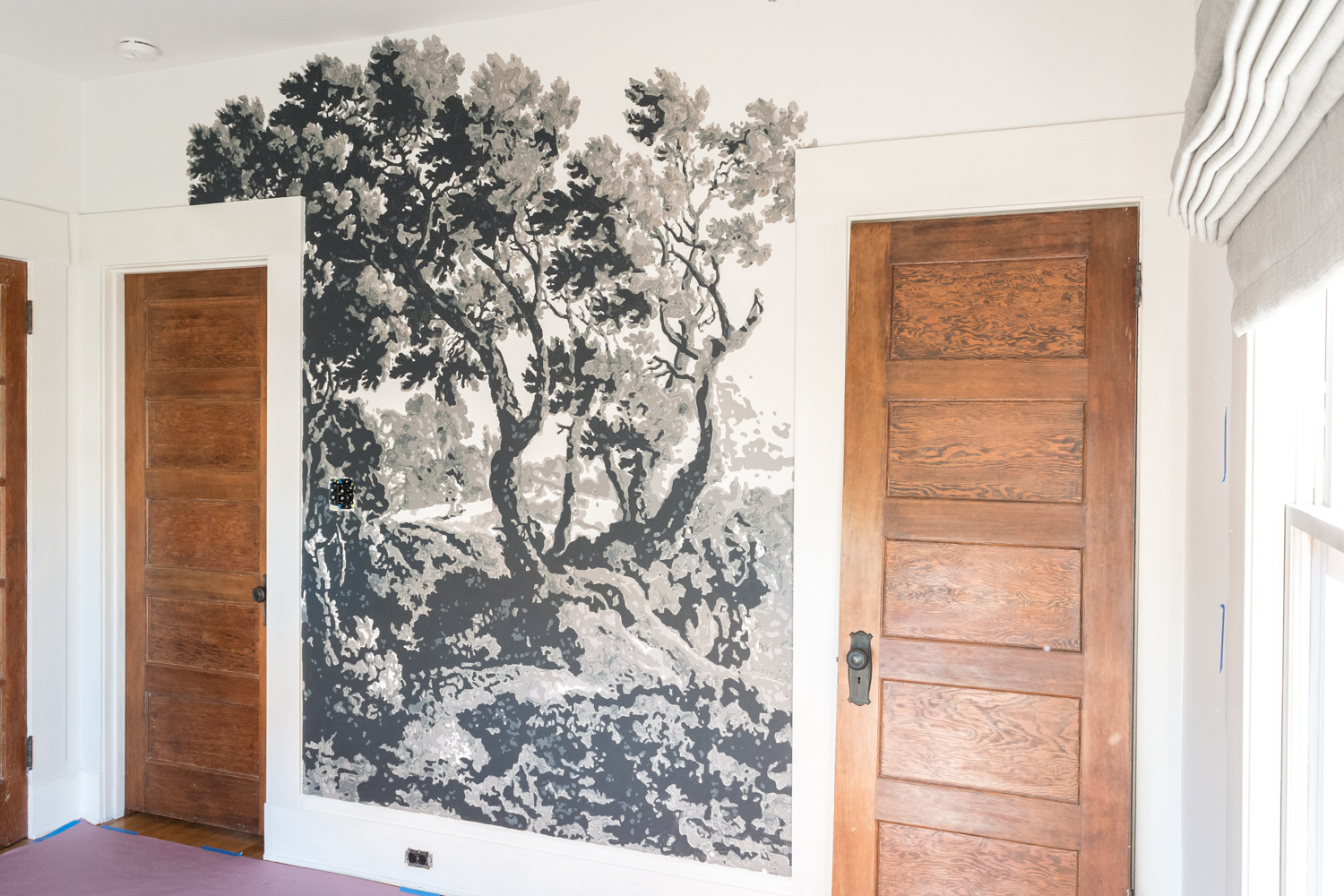
If you're just tuning in, I'm Ashley and I'm in the middle of transforming the home office of our 1915 craftsman bungalow in San Diego. Take a look at the plans which include a new layout, storage, lighting, furniture, and most importantly, a dramatic mural!
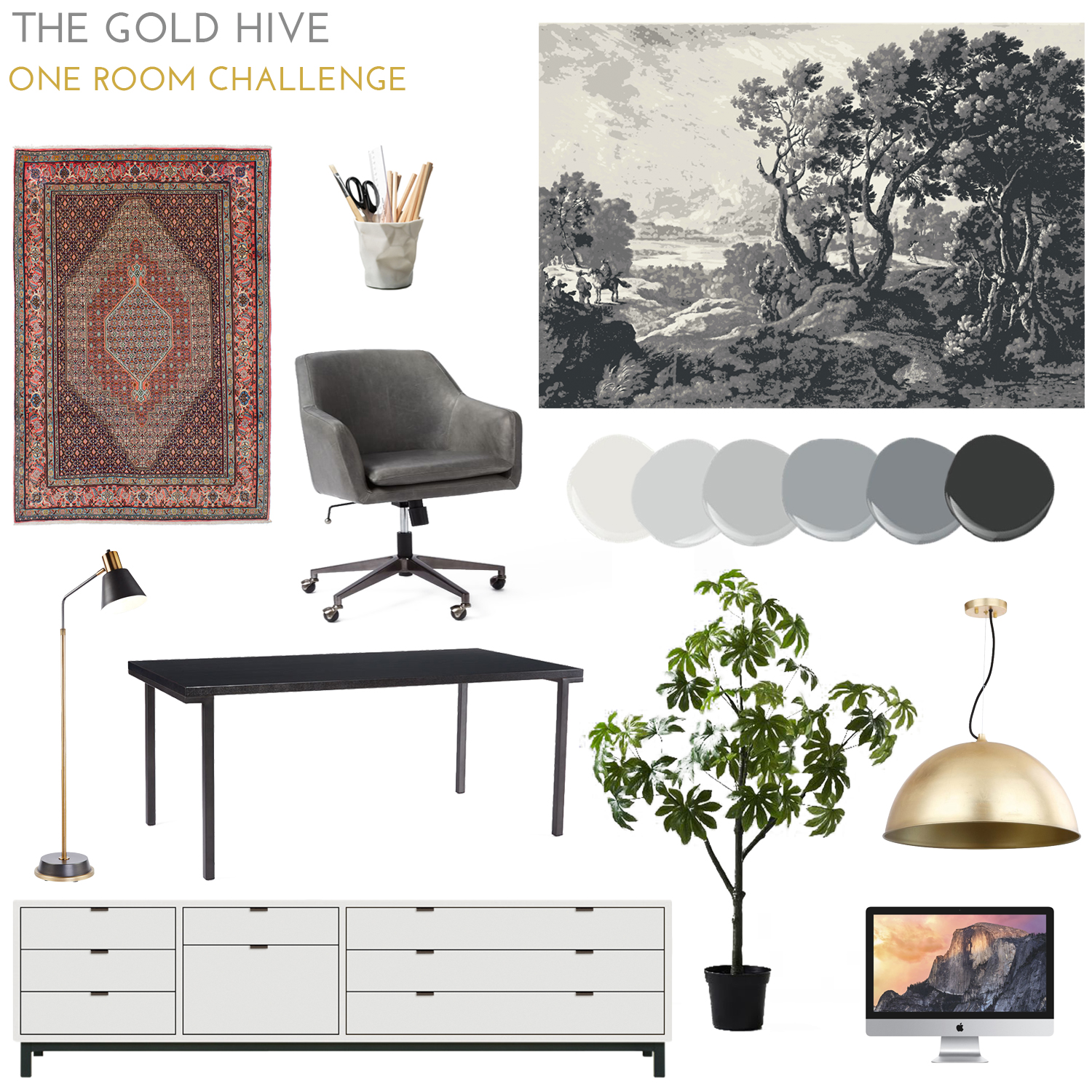
As a reminder, I'm painting an eight-color mural in a paint-by-numbers style. Take a look at last week's tutorial of how I planned to create a mural in the home office. It outlines sourcing a photo, modifying the design in photoshop, editing the image to cover multiple walls, and using a projector to cast the design onto the wall. It's worth reviewing to get some backstory on how this week's progress came to be.

If you're in an RSS reader, click through to admire the animation showing each color coming together to create the whole scene.
Without further ado, I started the mural!

I kicked off the painting on Friday night. Because starting at one end of the hue spectrum made more sense than bouncing around between colors, I launched the painting with the darkest shade since it takes up the most surface area.
This pretty deep color is Farrow & Ball's Off-Black. It took about 5 hours to do this layer from 10pm-3am - a real sacrifice because these are hours are when I get my best REM cycles in.

As a reminder, I was using my trusty projector and Photoshop to cast the image onto the walls for me to trace. It provided the perfect guide for each color as I turned off the hue layers that I wasn't painting at the moment.

Once the dreamy off-black color was on, I turned my attention to Farrow & Ball's Down Pipe which happens to be a very similar hue as the bathroom walls. This second layer took 7 hours - eek!
The next pretty shade was Mole's Breath which I guarantee looks better than what a furry animal smells like when they exhale. This coat took 5.5 hours.

The fourth color was Worsted, a rich warm grey. This one only took 3 hours!
After I got 20 hours into the project, I realized that I sorely overestimated how much I could accomplish during this tight timeline. I was 20 hours in, and only painted four out of the eight colors. PLUS! Each color would need a second coat.
Some of you on Instagram were kind enough to reassure me that the single-coat was still pretty. Thank you to all of you that gave me feedback as I shared live updates over the weekend! But, I really wanted solid chunks of color that looked like a true paint-by-numbers more than a textural pattern.
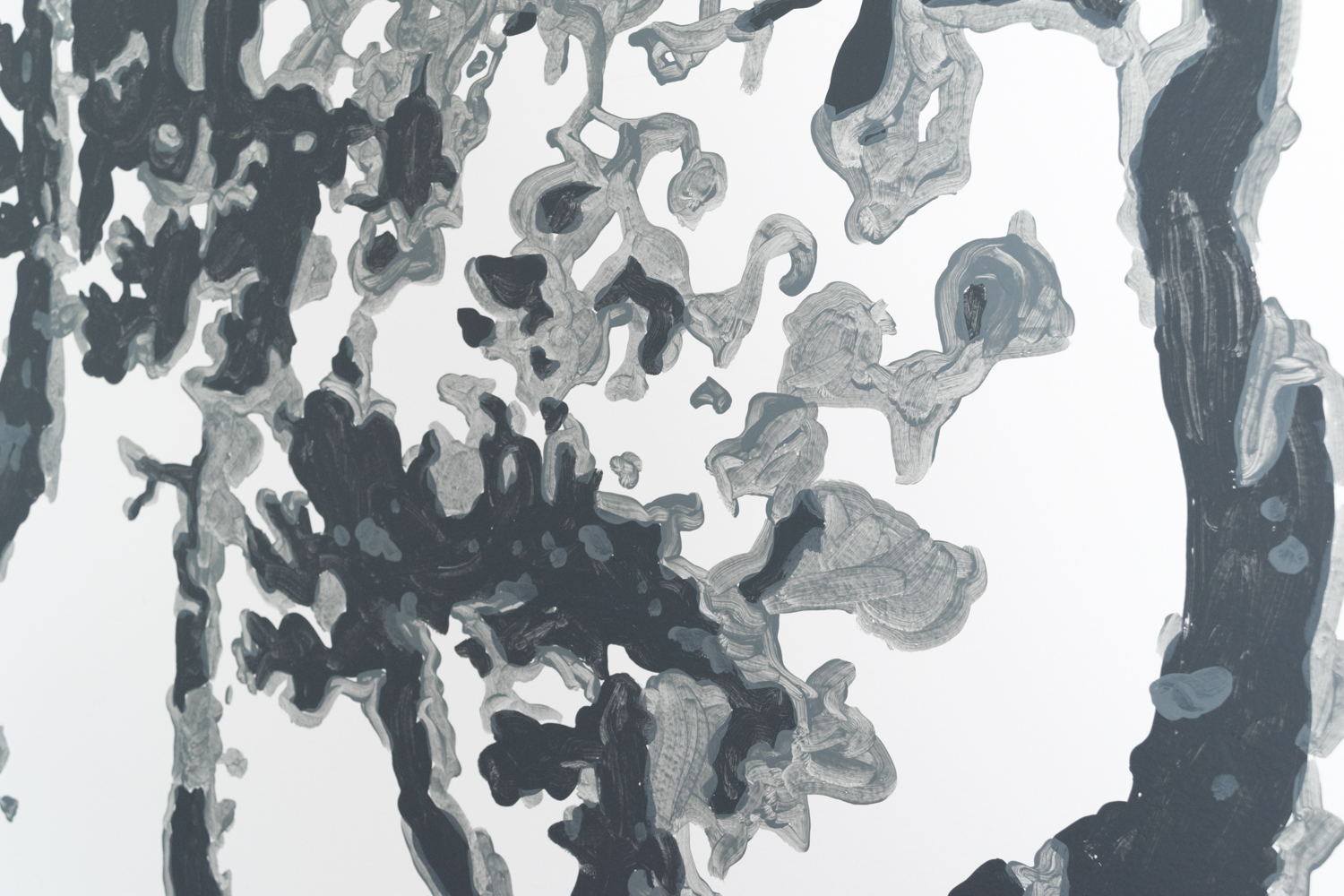
So, another slathering of paint is a must. I wish I could say that the second coat was faster than the first, but it wasn't. It took more time because instead of taking some creative license like I did with the first layer, which allowed me to apply the paint more organically, I now had to perfectly trace the existing color.
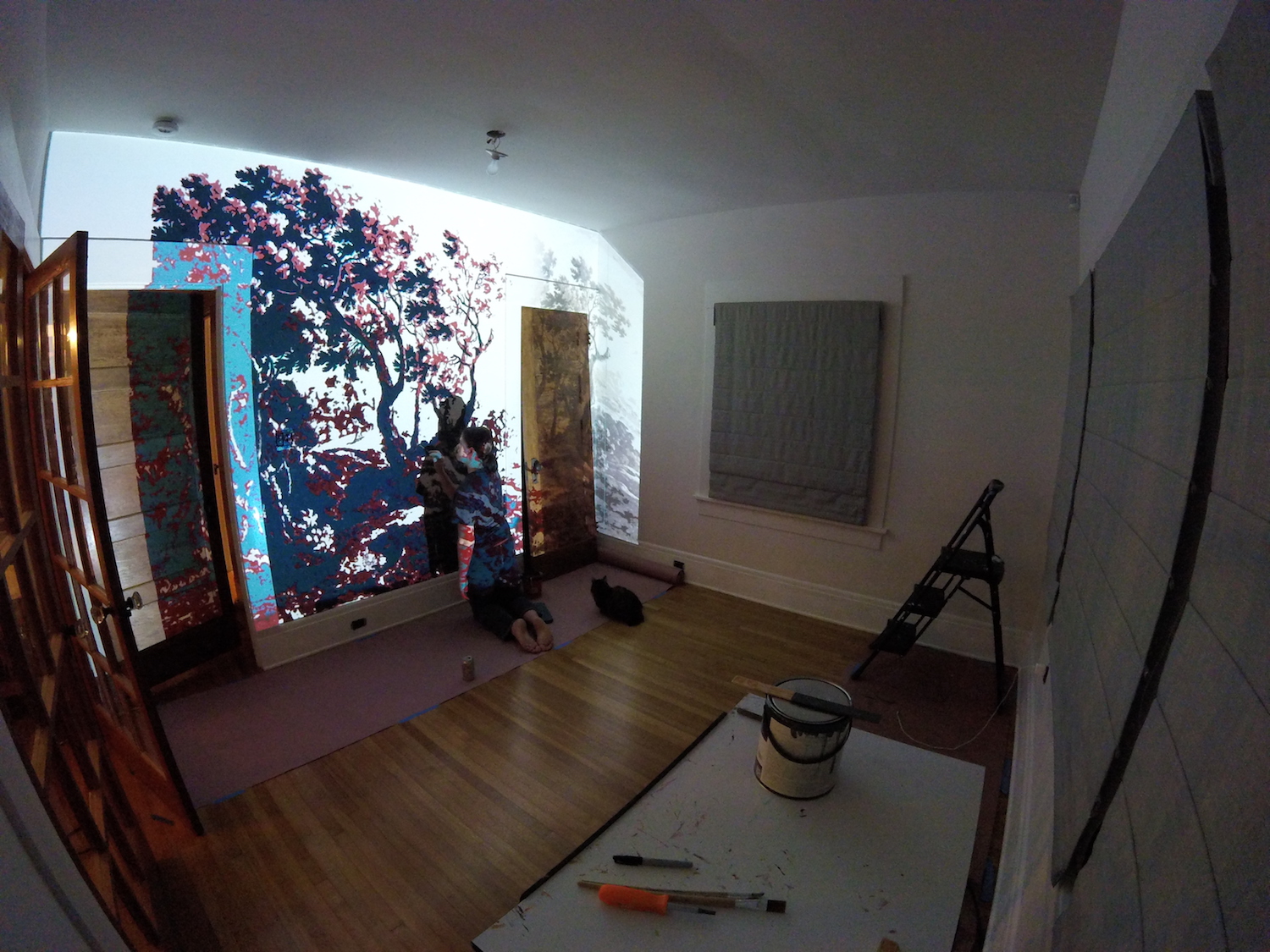
Do you see my site supervisor Mabel keeping an eye on quality control?
I want to point out that the process isn't hard. It's just time-consuming and can be boring. I listened to a bunch of podcast episodes of 99% Invisible before switching over to a David Sedaris audiobook. That guy's impression of Billie Holiday always cracks me up!
I'm not tallying up the hours to complain or seek pity, but rather to be totally honest about the process. I didn't just whip a mural together overnight and my art school background didn't save the day. Patience is the biggest skill you need if you aim to take on a project like this.

Now that I've stared the double coat process, I've put in about 30 hours so far, and have a few more hues to go! If I haven't scared you away from taking on a project like this, here are a few tips I've gained from my experience so far.
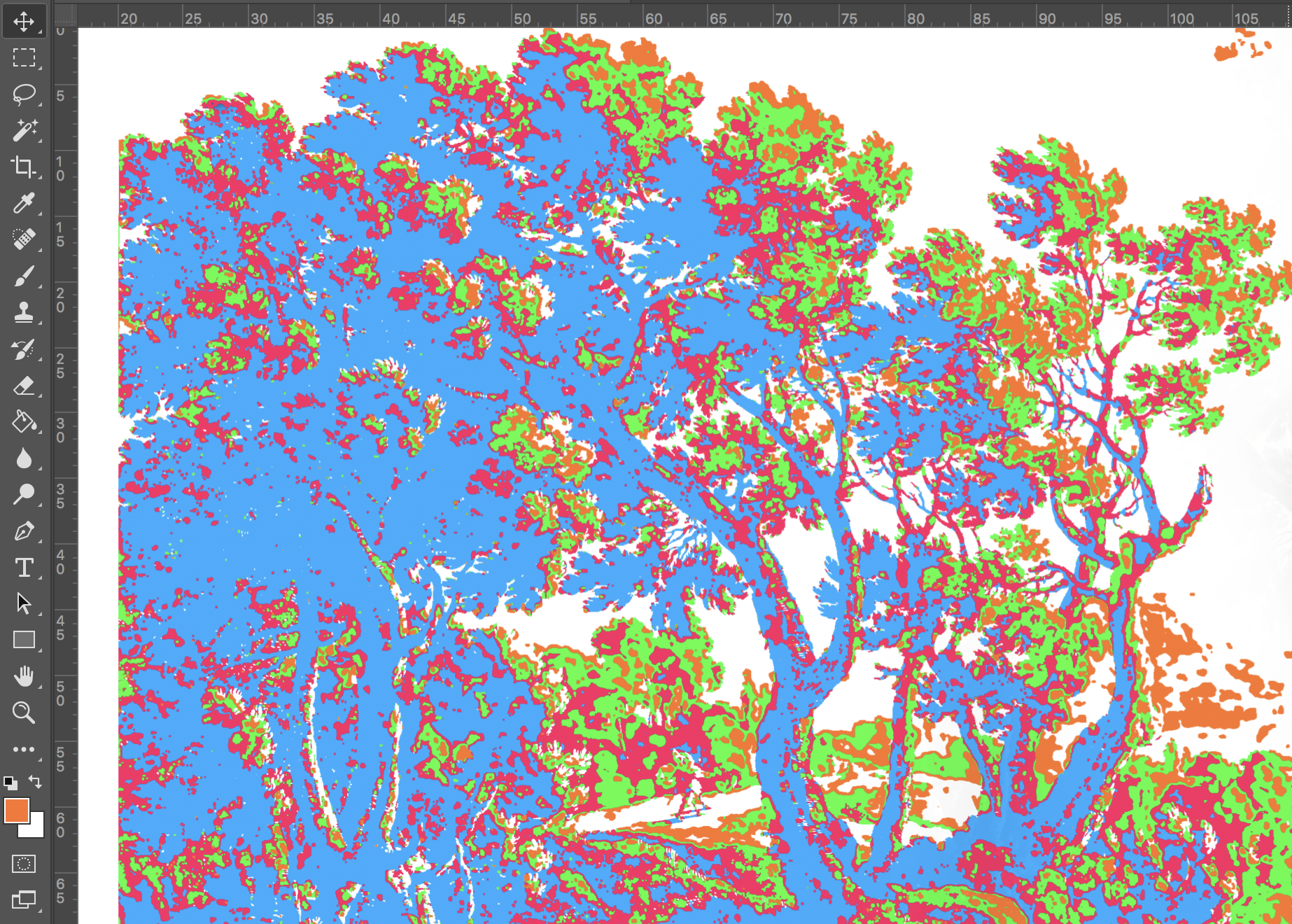
I explained in my previous post how to set up the projector. Since writing that post, a technique I found helpful is to color each hue a different bright color in Photoshop. This way, I can turn multiple layers on and clearly see each of them. At first, I just turned on each grey layer one at a time, but since the projector was known to move as I stomped around the room, maintaining visibility for each layer was super helpful.

Look how spiffy it is when those psychadelic colors project onto the white chair!

It seemed only fitting to use my childhood painting table/easel as my work surface. With so many paints, containing them in an organized fashion has been a must.

To keep each color organized, I'm using the HANDy Paint Pail and its corresponding liners - one for each color. I then labeled them accordingly. Whenever I want to use a shade, I pop it into the paint pail and paint away!
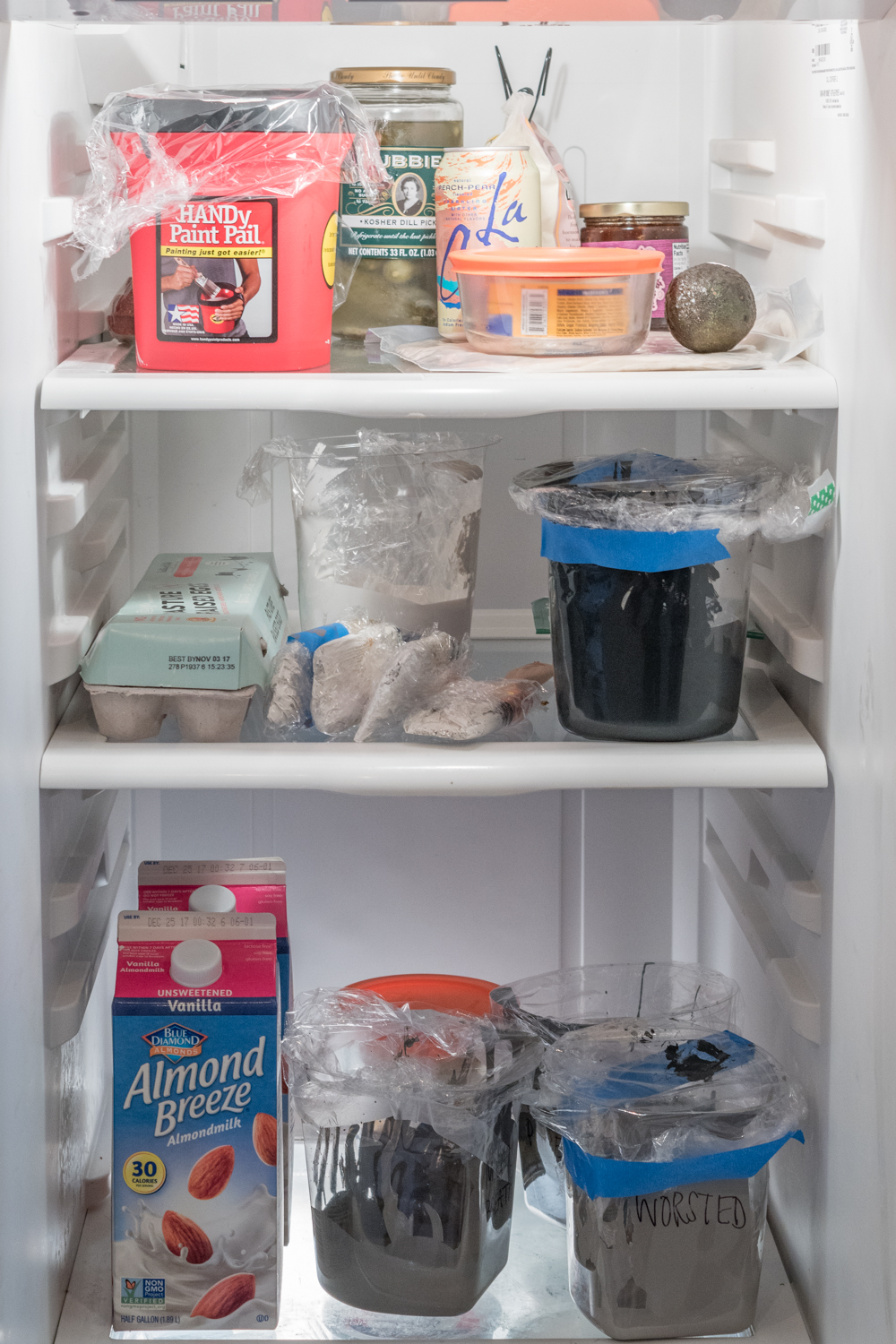
When I'm not using that color, I cover it in plastic wrap and pop it in the fridge. This storage method has definitely taken over my perishables. Do note, that I have been painting every day with small batches of paint. This storage technique doesn't last forever and will require dumping the paint and pouring fresh from the can every so often.

For brushes I'm using some old ones from high school and college, but any round brush for acrylics from your local art store would do the trick. Depending on the size of the image and the room, the detail will vary. For most of my mural, I've been getting away with a size 6 round brush, but certain images may require narrower brushes and others could get away with wider ones.
And that, folks, is where I'm at. I probably have another 40 hours of painting to go. There are 4 more hues to paint, 6 more colors to re-coat, 4 more walls to paint a solid color, trim to coat, and window sashes to give a dark hue. As you're reading this, I'm probably with a brush in hand!
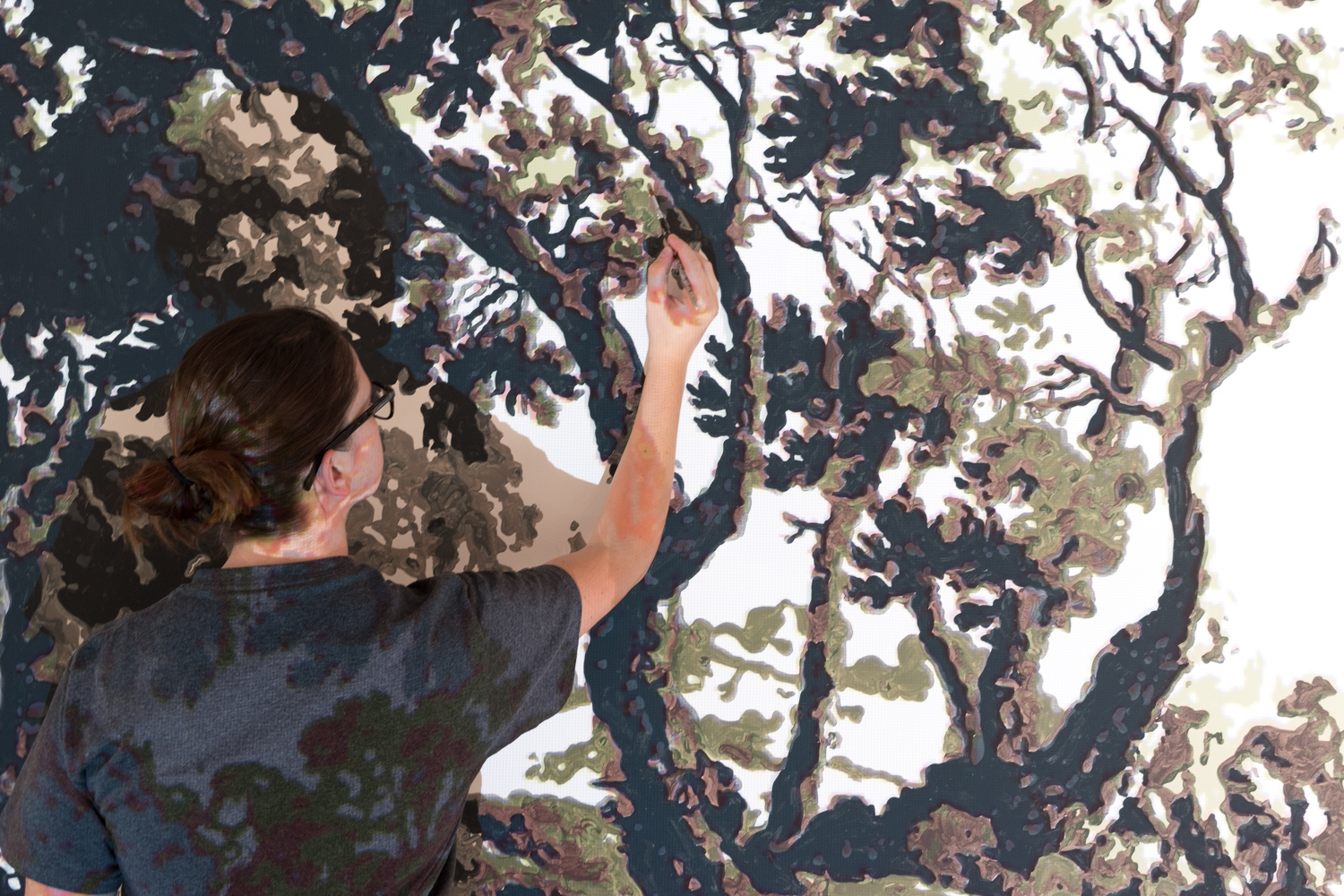
Come back over the next few weeks for more updates on the progress and set an reminder to return the morning of November 16th to see the final reveal!
I'm thrilled to have partnered with Farrow & Ball on this project. They generously provided me oodles of paint for this mural that's requiring eight of their beautiful grey hues. Their paints are the bee's knees so I'm excited to work with their quality and eco-friendly paints for this project. Thanks, Farrow & Ball!
If you're tuning in via the One Room Challenge and want to stay up to date on all of my home's transformations, subscribe to get future posts in your email! Also, follow along on Instagram for daily updates. You're seeing only a sneak preview of the mural, so be sure to come back for more progress updates!
Be sure to check out the featured design participants here and guest participants here, too!

Fall One Room Challenge progress:
Week 1 - the before, the inspiration, and the plan
Week 2 - preparing for a bold wall mural
Week 3 - tricks for creating a perfect wall mural
Week 4 - painting the mural
Week 5 - walls, windows, and shades
Week 6 - IKEA storage hack
Week 7 - the reveal!
Look back at the Spring One Room Challenge:
Week 1 - the before, the inspiration, and the plan
Week 2 - paint, paint, paint
Week 3 - how to install picture rail molding
Week 4 - sourcing the artwork
Week 5 - refreshing a chair
Week 6 - the reveal!
It's week three of the One Room Challenge and I'm barely making progress on the most dramatic part of the home office transformation - the mural! With only a few weeks to go, and lots of wall to cover, I'm worried about making the deadline! *insert nervous teeth-gritting emoji*

If you're just tuning in, I'm Ashley and I'm in the middle of transforming the home office of our 1915 craftsman bungalow in San Diego. Take a look at the plans which include a new layout, storage, lighting, furniture, and most importantly, a dramatic mural!

There are many options to buy wallpaper sized and designed to cover walls. But, why would I make it so easy on myself? Instead, I'm custom designing a wall treatment from an image I found online. If you, too, want to take on a project like this, here's how!
You can turn pretty much any photo, drawing, painting, etching, or image into a wall mural. I was initially inspired by centuries-old etchings, so that's where I started. My image was sourced from the Met's open-source collection of artwork. You can also find other great art downloads here and even Audubon images here (thanks for the bird tip, Marti!).
I selected this image called A Landscape with Travelers at the Left, an etching by Adam Perelle from the 1660s. When searching for an image, I wanted lush greenery that was neither suffocatingly dense like I was lost in the forest, nor super vast that would give some sort of trompe l'oeil look.
Depending on your image, you could skip this step and make a realistic representation of your image. However, if you want to make the process "easier," you may want to remove a bit of detail or avoid photo-realistic shading. So, you can convert it into a simpler color-blocked image for painting. Let's face it, we aren't all Chuck Close (yes, those are paintings - not photos).
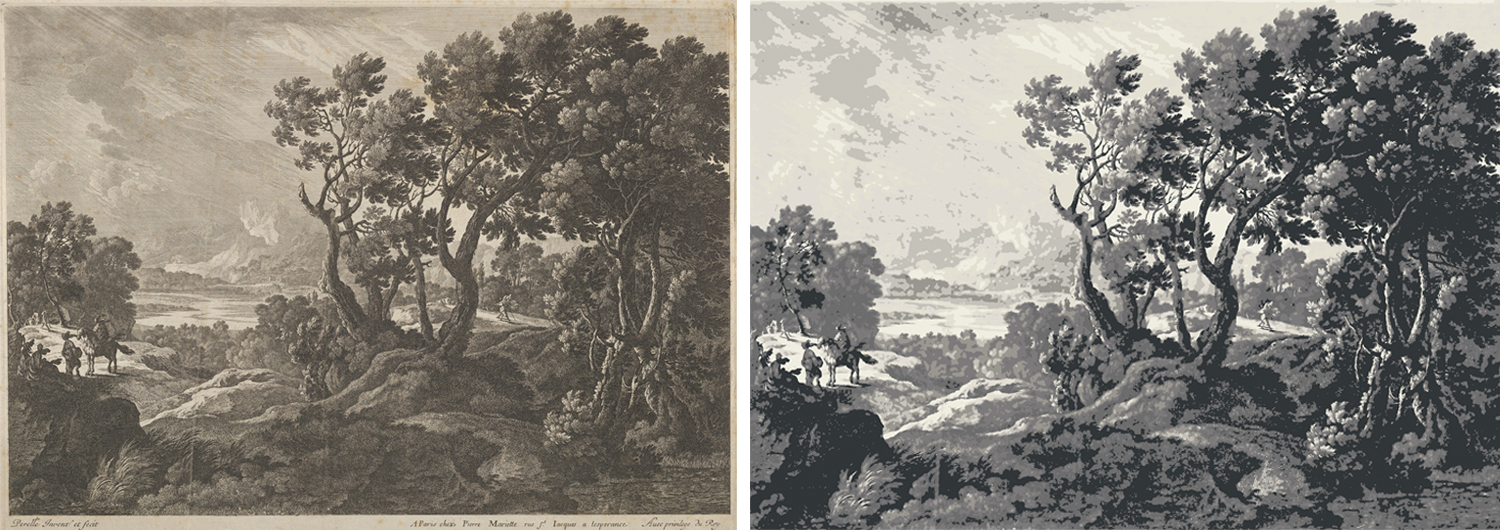
To simplify my etching, I converted it into a paint-by-numbers style image. No longer is it made up of small hash marks naturally found in etching, it is swaths of solid color. Instead of detailed line work and shading, the image is reduced to eight colors that, when combined, create the illusion of the shading and dimension of the original image.
Import your image into Photoshop.
Make any edits to your image like removing imperfections, cropping borders, or making color adjustments.
Click Filter>Blur>Smart Blur to blur out the details.
Define your radius and threshold by testing the different options. Select high quality.
Click Image>Mode>Indexed Color, then select the number of colors you want to paint and adjust the settings until it looks like a paint-by-numbers you are comfortable with.*
Click Image>Mode>RGB to convert it back to its original profile.
Click Select>Color Range and turn down the fuzziness, then use the eyedropper to select a color.
Create a new layer from the selection (command J).
Repeat steps 7 & 8 until you have a layer for each color.
*Instead of changing the mode, you can try the Cutout filter. It wasn't the look I was going for, but it will affect each photo differently, so give it a shot!

If you're in an RSS reader, you'll want to click through to admire this spiffy gif that shows each layer of paint. Really, who doesn't love a good gif?
If you want to do a mural on only one wall, then you can skip this step. However, I wanted the landscape to wrap around all four walls and give the illusion of a continuous image. Because the dimensions would certainly not wrap all the way around, I duplicated, mirrored, and modified the image in Photoshop.

The diagram above shows each of the four walls divided by blue vertical seams. The dark grey cutouts are the doors, windows, and baseboards. To do the same, create a Photoshop file with a canvas size the same dimensions of your room (or a scaled down version). Then, block off each part of the wall that won't get paint, like doors and windows. No need to account for light switches. Then, import your layered paint-by-numbers file and duplicate and modify it as you like.
When you look at the image panorama, you can see where I duplicated and mirrored parts of the scene. You can make all the tweaks you want on your image, but don't stretch the image, which would distort it. There are a few spots that look too similar in the image above, so I'll be making modifications freehanded. Pay attention to details as they wrap around the walls. Do you want all of the clouds circling in the same direction, or do you want the illusion of the gusting from one direction? It's your call, but this is the time to make the edits!
The most effective way to get a photo from Photoshop to your room is with a projector. I'm using this short-throw HD projector that's able to cover an entire wall at a nice resolution. When shopping, be careful of low-res projectors that won't fill up your whole wall. Otherwise, you'll have to puzzle piece your way around.
Isn't she pretty?
First things first, kill the lights and draw the shades. Projectors like the dark.
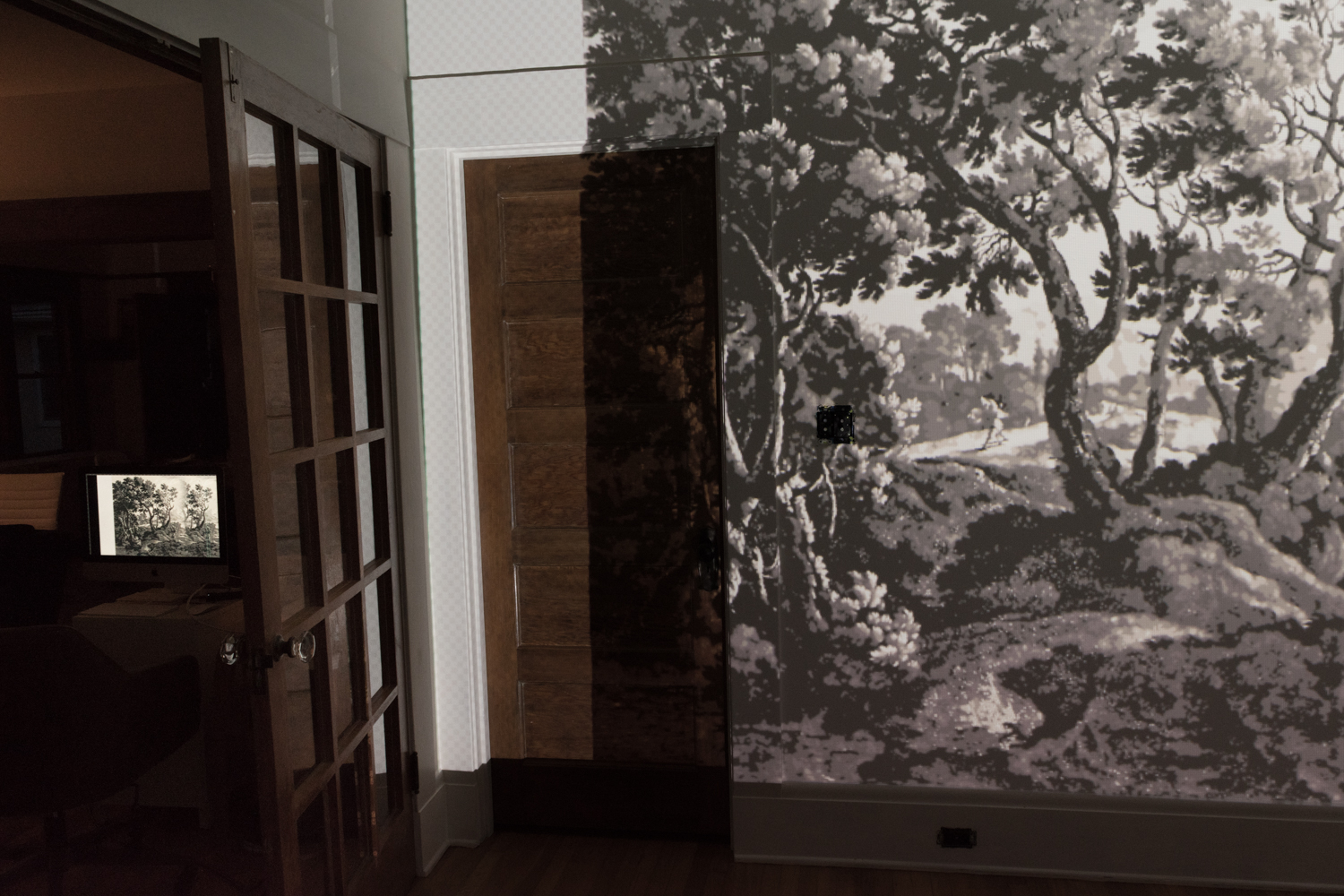
I set up my iMac on a small filing cabinet outside of the office. I want it nearby for making edits and turning off layers (more on that in a minute) but I wanted it far enough away that it isn't in danger of getting painted. It connects to the projector with a 25' long high-speed HDMI cable.
Lining up the image is key, especially if you'll be covering multiple walls. Avoiding distortion is important so it doesn't feel like the trees are leaning in on you or falling sideways. To do this, I created shapes overlayed on the image to line up the projector. Points on the top and the bottom helped me line the image up with the architecture of the room, and a square in the middle sized to 12"x12" in Photoshop gave me a guide to measure with a tape measure on the wall.


The scene for passersby probably gave the impression I was running a cult. Maybe I should use the projector for spooky Halloween decor while I'm at it.
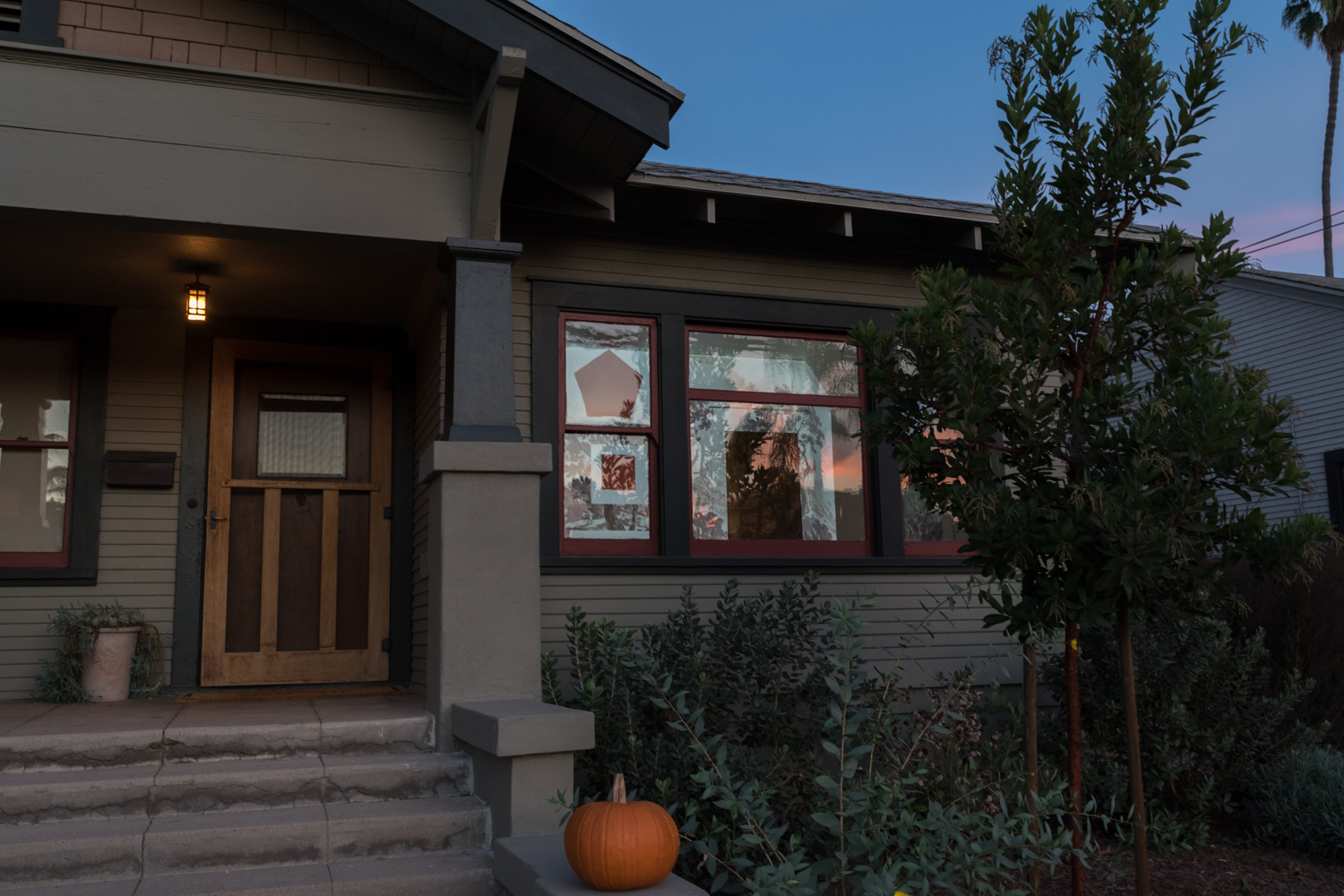

I'll admit that setting up the projector for the first time was quite time-consuming. We had to figure out the right zoom on Photoshop, the best distance to place the projector from the wall, and we also had to shim it up to have the right angle on the wall.
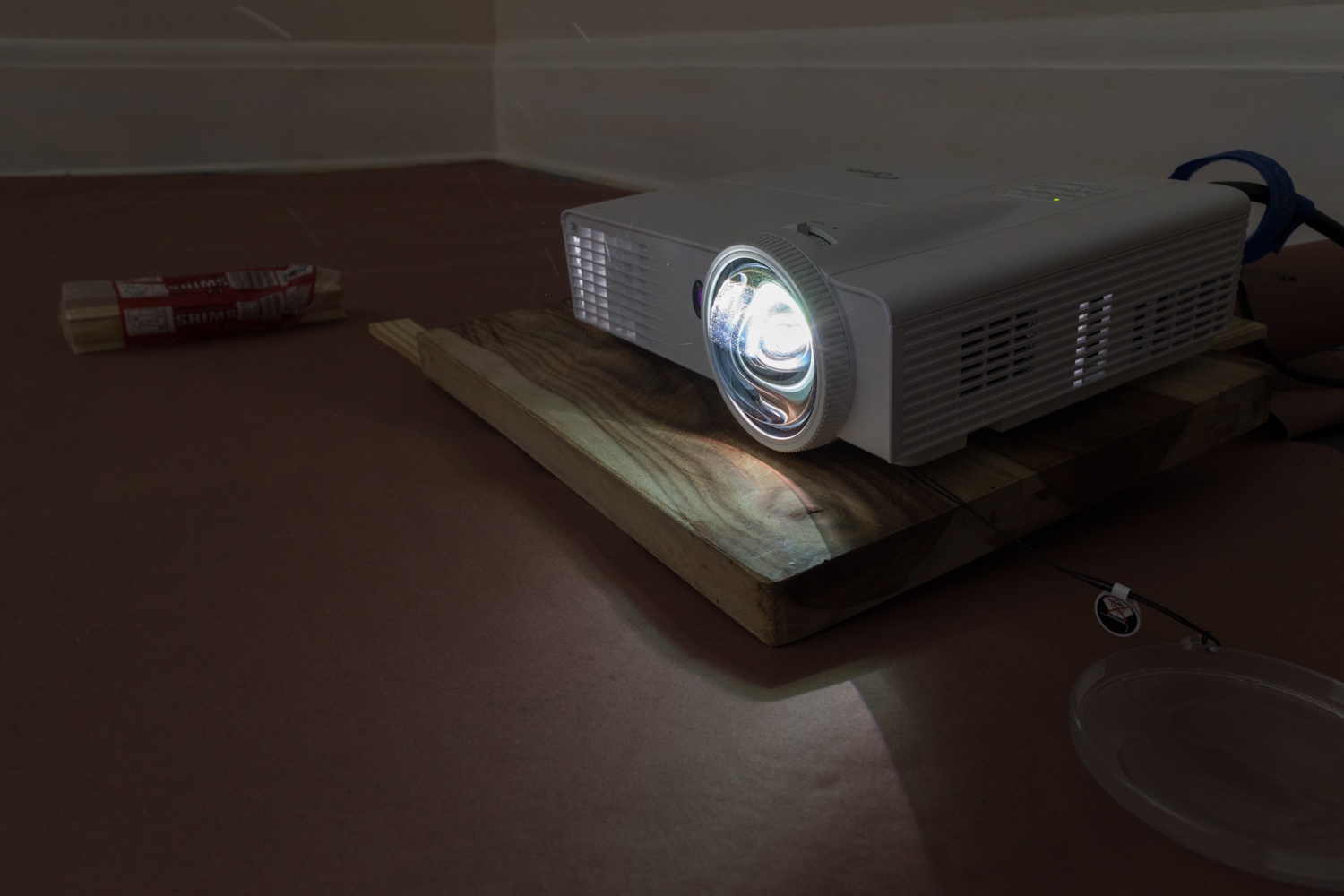
So, now that the projector is shining pretty, you can get to painting.
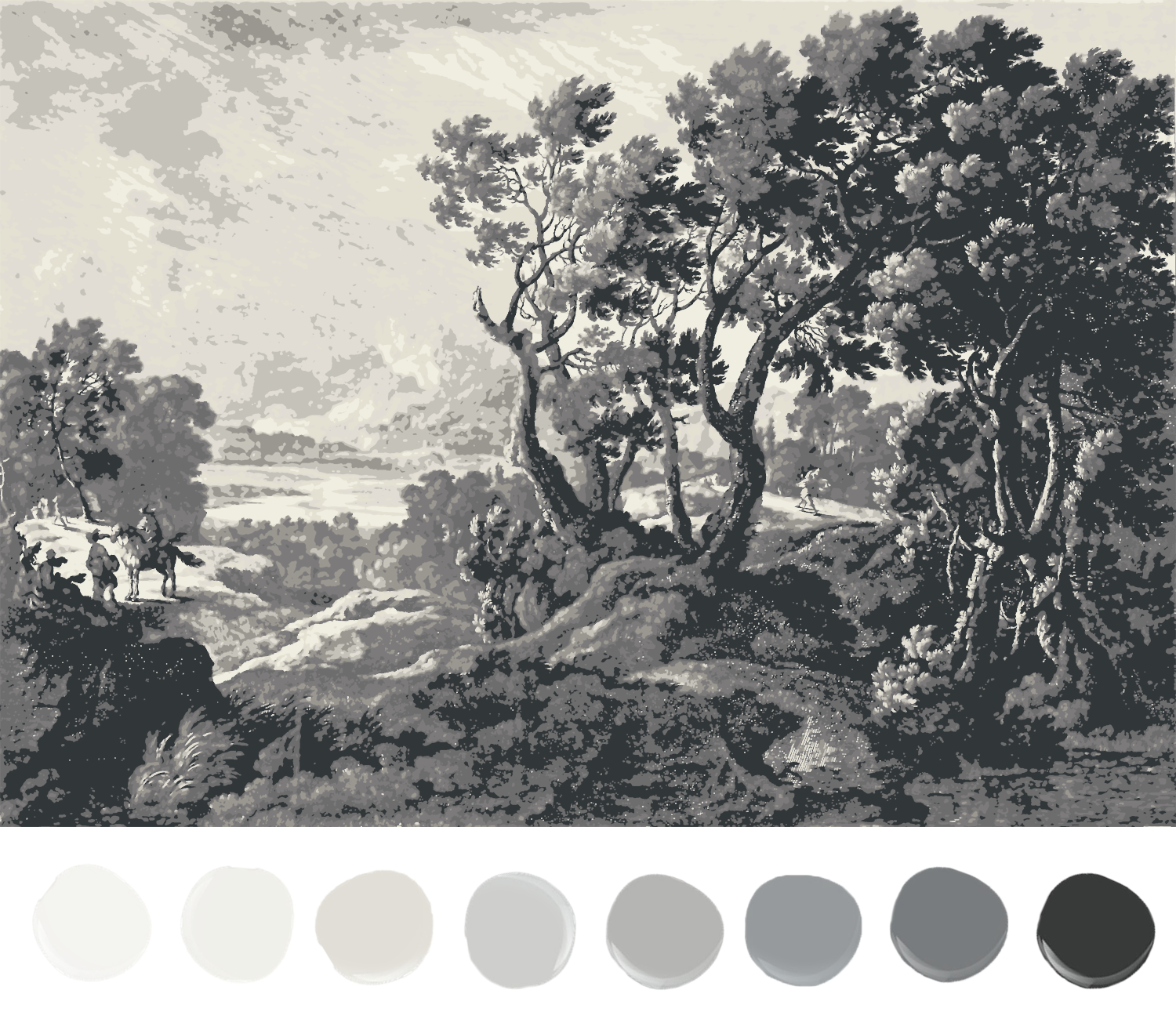
Remember that spiffy gif from before that broke down each of the colors on their own layer? Well, this is when it comes in handy.
Depending on your design and the number of colors, you could paint using the full image. However, I think that isolating colors and painting one color over the whole wall, then moving to the next color and the next color is the best way to cover ground - err walls.
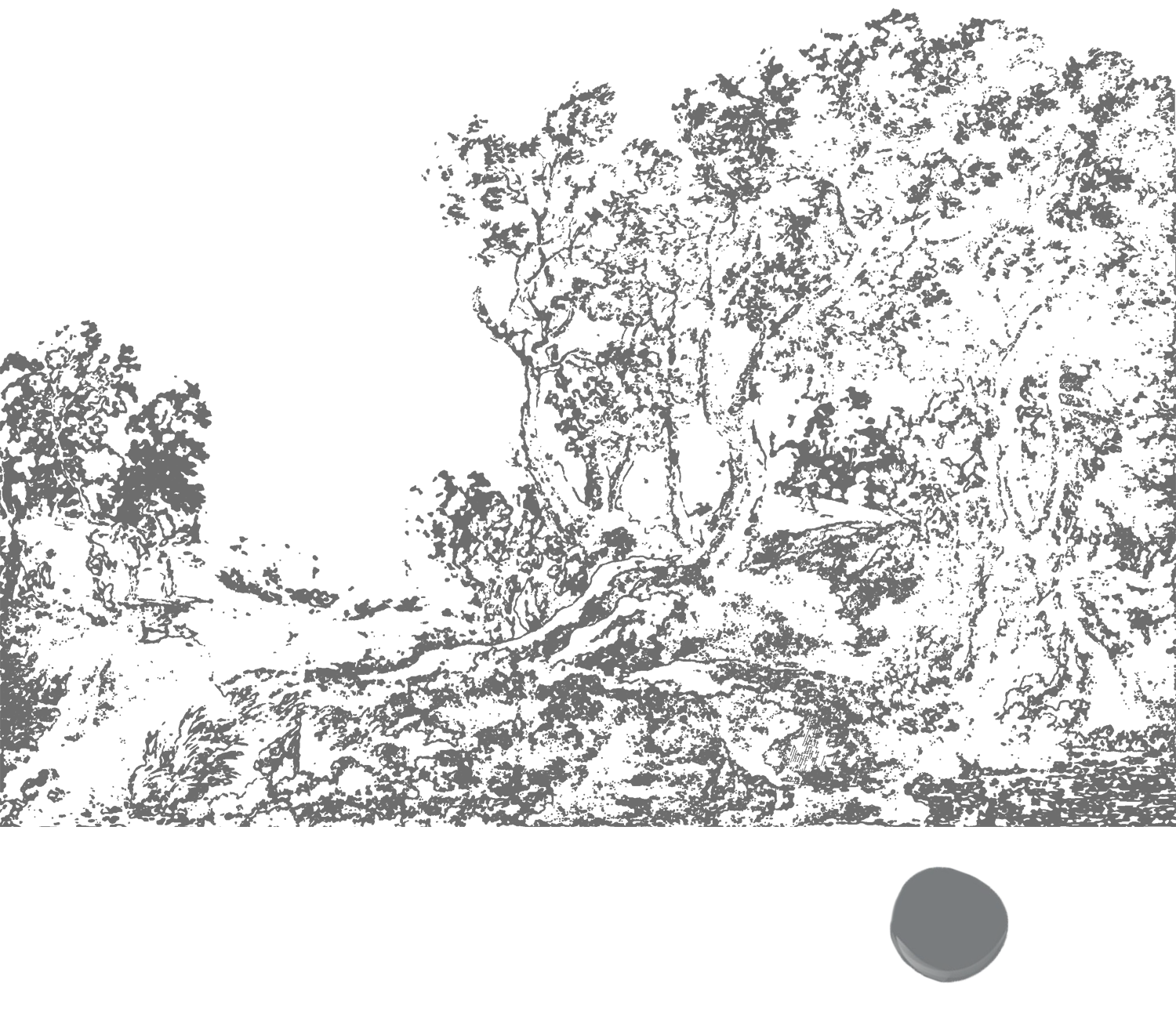
To see only one color at a time, you'll turn off the layers of the other colors. Then, paint away by tracing wherever that color is on the wall. Thanks for the help, projector and Photoshop!

The dark shades show up nicely on a white wall, but the light colors often need help by creating a high-contrast background. Adding color helps differentiate it from any greys you may have on the wall already. Alternatively, you can tint the actual color layer that you're working on, rather than its background. It's up to you and how much color/light your eyeballs can handle.
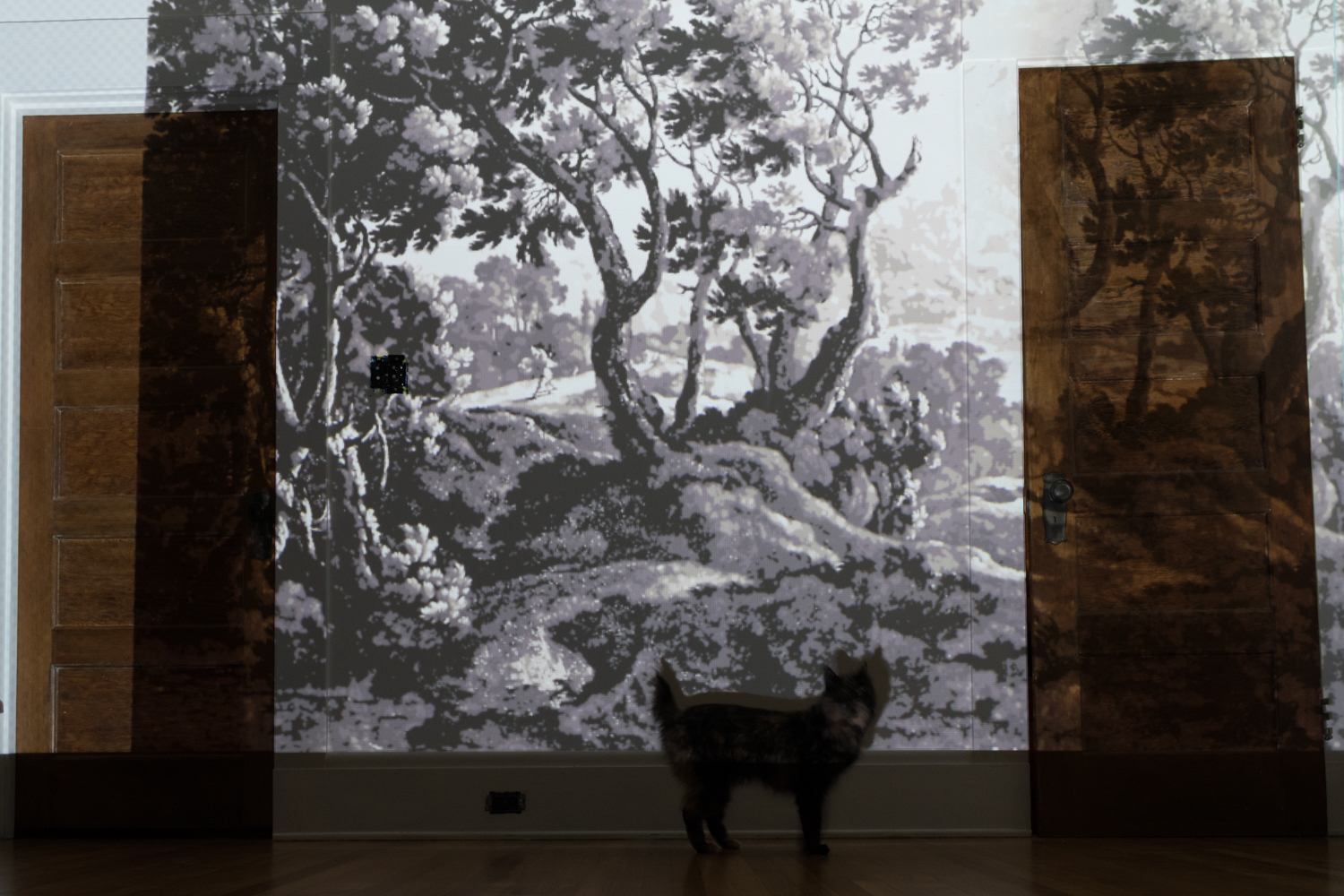
The projector creates a template to guide you. Just follow the shapes and lines to replicate the projected image onto your walls. It's basically just tracing - but on a big scale!
Then, repeat, repeat, repeat, repeat, and repeat for all eight colors and four walls. Did I mention that I haven't started the mural yet??? The paint only just arrived and I had lots of prep including moving the ceiling light box and some other odds and ends. Wish me luck! I'll be back next week for painting progress and tips.
I'm thrilled to have partnered with Farrow & Ball on this project. They generously provided me oodles of paint for this mural that's requiring eight of their beautiful grey hues. Their paints are the crème de la crème, so I'm giddy with excitement to be working with their quality and eco-friendly paints for this project. Thanks, Farrow & Ball team!
If you're tuning in via the One Room Challenge and want to stay up to date on the progress of this project and see what I have coming in the future, subscribe to get blog posts in your email! Also, follow along on Instagram where I'll share stories of the transformation along the way.
Be sure to check out the featured design participants here and guest participants here, too!

Fall One Room Challenge progress:
Week 1 - the before, the inspiration, and the plan
Week 2 - preparing for a bold wall mural
Week 3 - tricks for creating a perfect wall mural
Week 4 - painting the mural
Week 5 - walls, windows, and shades
Week 6 - IKEA storage hack
Week 7 - the reveal!
Look back at the Spring One Room Challenge:
Week 1 - the before, the inspiration, and the plan
Week 2 - paint, paint, paint
Week 3 - how to install picture rail molding
Week 4 - sourcing the artwork
Week 5 - refreshing a chair
Week 6 - the reveal!

I don't like to go wild with decorating my home for the seasons, but I love that Halloween gives me an excuse to display eerie, weird, dark, melancholic, spooky, mischievous, and creepy artwork. I've collected some of my favorite vintage art from Etsy that could be great all year long but has a particularly spooky vibe during the month of October - especially en masse. All of these are available for purchase and should make it to your home in time for All Hallow's Eve. Enjoy!
How do you like that bearded man's side eye? And that girl's mischievous look? Pretty much any daguerreotype is perfect for Halloween decor by the nature of it.
Sorry to any of you that don't like creepy crawlies. Can I interest you in some bones?
Those retro anatomy prints are so cool. They are available on Etsy, but are also sold in an awesome brick & mortar shop in Joshua Tree. It's a must stop if you're in the Palm Springs area!
These still lifes are anything but lively.
I genuinely find cemeteries to be beautiful. Anyone else with me?
Happy (almost) Halloween!
Welcome to week two of the One Room Challenge!
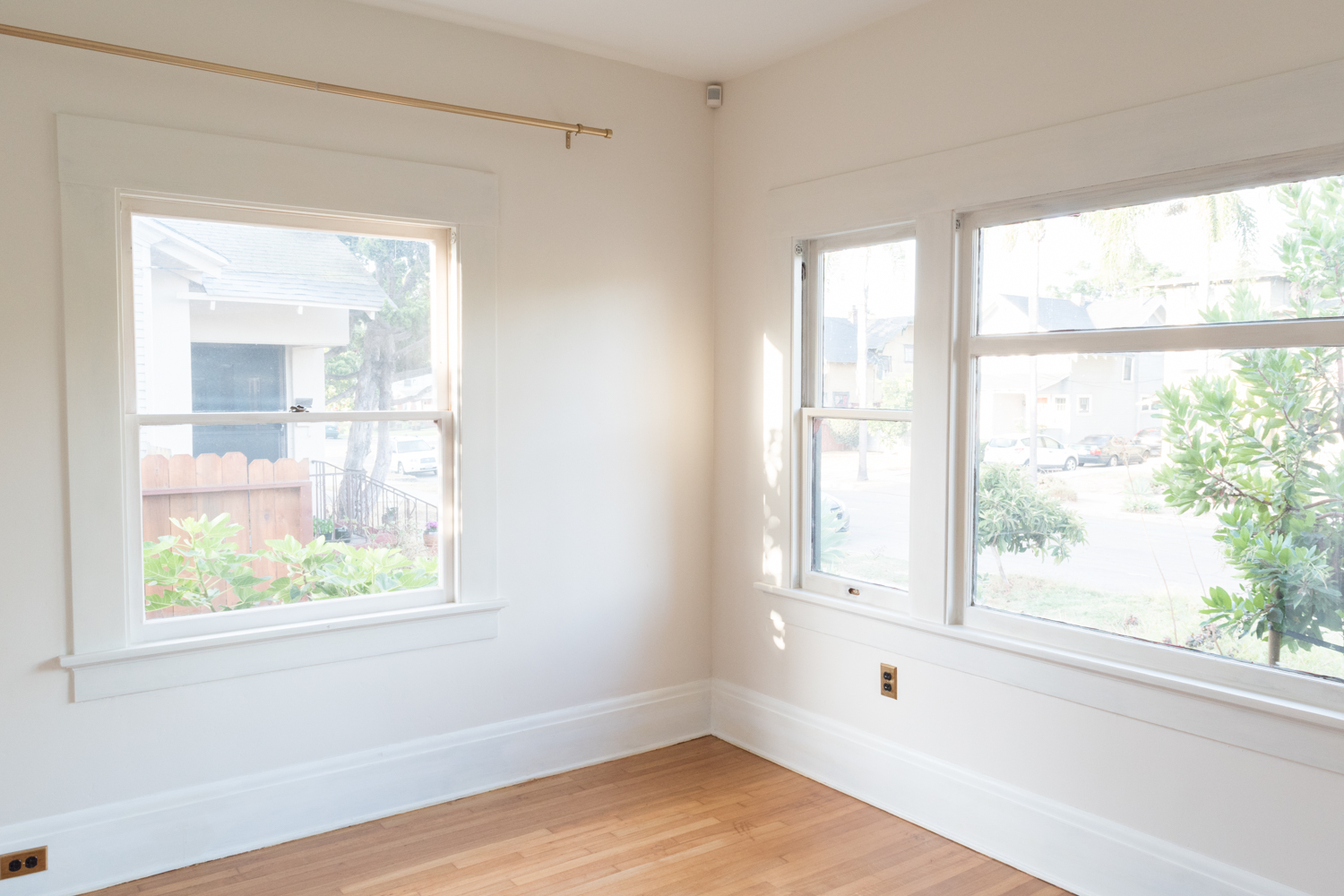
If you're just tuning in, I'm Ashley and I'm in the beginning of transforming the home office of our 1915 craftsman bungalow in San Diego. Take a look at the plans which include a new layout, storage, lighting, furniture, and most importantly, a pretty cool mural! For a refresher, here's where we're headed.

Week two is often pretty slow going - these last few days were all about preparing for the statement wall treatment. It's true when they say, "prep is the most important part of painting." It took a couple of days to sand, patch, prime, caulk, patch again, prime again, and finally, clean up. It already feels like a transformation, and we're only on the priming stage!
All this effort was put into the trim to give it new life. For anyone concerned about painting the woodwork, take a look at my logic here.
To see what I've been up to this past week, scroll through below. Note, it isn't dissimilar from watching paint dry.
First, I used a coarse grit sandpaper on my orbital sander to knock down the existing finish and remove the splinters.

The sander worked wonders for evening out the texture (I meant it when I said there were splinters on the interior woodwork). Shaving off the finish also gives the primer solid wood to grab hold of.

I only sanded the door casings because the doors are in great shape, even though the trim was rather unfortunate. The baseboards were already painted. To get an idea of the state of the wood and how I decided to paint it, check out this post.
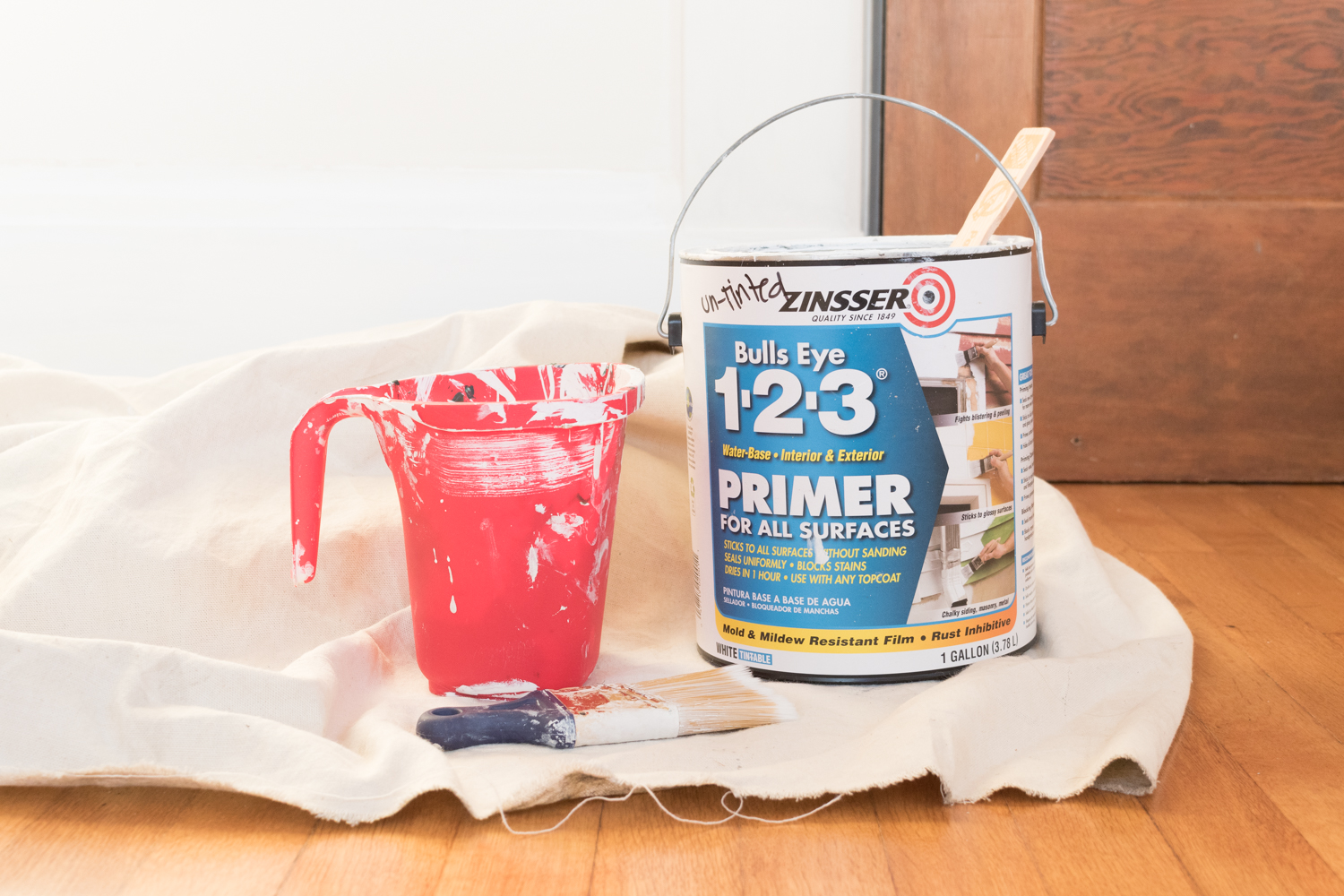
After sanding, I followed up with my go-to primer, my go-to paintbrush, and my go-to paint tool.

There were oodles of gouges in the wood and nail holes to fill. Some like to fill these gaps before priming, but I like how a thin coat of white paint helps to show each of the imperfections needing patches.
I like to use this putty. It's really easy to control and doesn't need sanding, but does require a long dry time (24-48 hours). My favorite caulk works wonders and can be painted in 30 minutes. My tip for caulking is to use a small container with water and a few paper towels for cleaning up messy fingers, and for dipping into for a smooth swipe along the bead of caulking.
After patching the holes, I did another layer of primer to be extra prepared. And I mean, once you're in your painting clothes, why bother stopping?

For more painting tips and tools, I always have a kneeling pad, a sturdy step ladder, two drop cloths (one for sliding around as I move throughout the room and one for keeping all of the supplies), an interchangeable screwdriver for removing hardware, clean paintbrushes for dusting, a can of LaCroix (can you spot it in the above photo?), stir sticks, and most importantly, a device for playing podcasts and tunes.


The reason the trim blends into the walls is that I used leftover primer from when I painted these walls. I had it tinted to the wall color (hot tip!) so the window casing isn't exactly popping off the wall right now. Not yet, at least!

Yep, that's a GoPro. Prepare yourself for a timelapse of the mural application!


Just look at how happy those doors are surrounded by a crisp blanket of white paint rather than neglected woodwork.



For a satisfying step-by-step, click through these images below.
All of this was laborious and not a wildly dramatic transformation, but it's a necessary step to get to a blank state before applying those 8 shades of grey to the walls. Come back next week for some mural progress!

If you're tuning in via the One Room Challenge and want to stay up to date on the progress of this project and see what I have coming in the future, subscribe to get blog posts in your email! Also, follow along on Instagram where I'll share stories of the transformation along the way.
Be sure to check out the featured design participants here and fellow guest participants here, too!

Fall One Room Challenge progress:
Week 1 - the before, the inspiration, and the plan
Week 2 - preparing for a bold wall mural
Week 3 - tricks for creating a perfect wall mural
Week 4 - painting the mural
Week 5 - walls, windows, and shades
Week 6 - IKEA storage hack
Week 7 - the reveal!
Look back at the Spring One Room Challenge:
Week 1 - the before, the inspiration, and the plan
Week 2 - paint, paint, paint
Week 3 - how to install picture rail molding
Week 4 - sourcing the artwork
Week 5 - refreshing a chair
Week 6 - the reveal!
If you’re an old house lover like me, you probably adore unpainted woodwork. Right? It’s so rich in character and shows the beautiful age of the home. A big selling point for our current home was the unpainted wood. Friends would ask me when I would paint it, and I'd scoff at them and exclaim, “never!” I vowed to love that fir and never let anyone hurt it.
Then, after much deliberation, I ultimately painted some of the trim.
Before you hit “unsubscribe” and tell all your friends to grab their pitchforks to run me out of the old house fan club, hear me out! The woodwork in our home is very damaged. I would never ever ever condone painting mint condition gumwood wainscoting. Ever. I would never say, “go ahead and remove that custom wood built-in to make room for a wine fridge.” Ever. If you have beautiful woodwork, don’t paint it. I’d rather see you buy a different house so someone else could enjoy the woodwork if you don’t like it. Seriously.
First things first, once you paint wood, you can never go back. Painting 100-year-old wood for the first time is signing its death sentence. And you see, all of the wood in our house was previously painted. All of that fir you see now was once slathered in layers of paint. There are ghosts of the previous paint all over our trim in the form of nail holes and gouges filled with paint and putty. It’s not pretty and it would only go away if I took dental tools to each panel and scraped out a trillion pieces of paint. Believe me, that is in my future when I do it for the dining and living room woodwork. Oy!
Termite damage is no joke. Those pesky bugs have gnawed on wood in each and every room of the house. Remember when they ate through the subfloor in our master bedroom? Remember when they ruined the fir floor in the kitchen? UGH! Once termites get hold of your windows or your casings, there’s no going back. You can fill their tunnels with wood putty and have a scar from the bugs of yesteryear, or you can replace the whole brittle piece of wood. Neither of which will ever truly blend in.
Human neglect is sad. The panels in our master bedroom door had gouges that I can only guess came to be when someone used the door as a dart board – but with kitchen knives instead of darts. Another bedroom door had evidence of a padlock that required cutting a 1”x2” piece out of the casing. Now, I'm all for seeing the history of previous lives in an old home. But character is a worn finish on a newel post from decades of hands touching it, not knife marks and padlock damage. That's just eerie and unwelcome.
In addition to termites and knife marks, the trim in our office was so damaged that I’d get splinters from touching it. Scorching sun damage and rot hasn't helped matters. It’s painful to look at sad trim and evidence of its neglect.
Ok, so you still don’t agree. You say to fill the knife marks with putty and replace the window sill that’s brittle with termite damage, then stain it to match. I hear you, that would work. But, when you’re patching a good portion of the room with new wood to look like old wood, at what point is that better than filling the holes with putty, then coating a nice layer of paint over top? A well-patched window with a coat of pretty paint still shows the shape of the wood that someone carved by hand 100 years ago. Having it painted has you focusing on the chunky wood, the historic significance of the profile, and the stateliness of its place in your home rather than the evidence of neglect and damage.
One of the biggest reasons to keep the old wood and patch it rather than replace it is for the sake of the environment. I’m keeping the old wood in my house instead of the landfill. No energy is spent trucking it to the landfill and it doesn’t sit in a sad pile of rubble for another century. Also, no energy is spent growing, harvesting, and processing new wood - all are significant energy consumers and waste producers.
I also decided that the bedrooms (of which the woodwork was once painted dusty pink in the master, powder blue in the current den, and canary yellow in the kitchen – cute!) were an appropriate place to have painted trim - more so than living and dining areas. Also, how stinking cute did the house sound with all of those pastel colors? Should I bring those colors back?
I stand by my decision to re-paint the damaged woodwork in an effort to revitalize it. My goal was to maintain the original wood by removing the evidence of neglect, rather than replacing it and trying to give the illusion of perfectly unpainted wood. At the end of the day, I appreciate that the original wood is there, the hand of the craftsperson is still evident, and that the character remains. But, I understand if you disagree, and that’s okay. I’m grateful for those old wood purists that do anything to expose unpainted wood! I urge you to give me advice for the trim in the living and dining room that I refuse to paint. Please, I’ll gladly take your wisdom on how to get through the hours of plucking paint out of nail holes!
All this is to warn you that I painted the trim in the home office for the One Room Challenge. Spoiler: I kept the doors unpainted (because they were in good shape) and they are simply glowing now that they aren't surrounded by mucked up trim.
I give you a collection of photos that show a mere sliver of the state of the wood in the office:
Note that we removed the vinyl window and replaced it with a wood window last year, so those plastic bits are no longer.
I hope this explains how an unpainted wood purist became one of those people that paints trim!
Do you remember that time earlier this year when I transformed our den? That time when I painted the walls a deep moody green, installed picture rail molding, reupholstered a chair, sourced new art and furnishings, and also blogged all about it? That time when I did all of that in a matter of six weeks? Well, if that wasn't enough speedy home design for one year, I'm doing it again this fall!
That's right, I'm participating in the One Room Challenge for the second time! I've selected another neglected room in our house to completely redesign. Eek!
If you found me through ORC, welcome! I'm Ashley and for the past two years, I've been restoring a craftsman bungalow in San Diego, CA. Learn a touch more about me here, and preview the before-and-after room transformations here.
Our home office is the most neglected room of the house. It didn't even earn a viewing in the recent Design*Sponge feature because it's too darn bland.
Before I get into what the home office looks like now, I'll give you the plan and the inspiration first!

The biggest part of the transformation is the wall treatment. I'll be hand-painting a mural on all four walls of the room with pretty grey tones!
I was inspired by these wallpapers that mimic etchings.
In search of a unique etching, I went to The Met's open source catalog of art and selected this beauty. After a few tests, I decided the etching look wasn't the best option for hand-painting a room in six weeks, so I've modified the image to mimic a paint-by-numbers.

I'm exhausted just thinking about painting eight different greys on each wall in the likeness of that etching, but I can't wait to see the final result! I hope you'll follow along!
Since I know you're itching to see the befores, here you go!
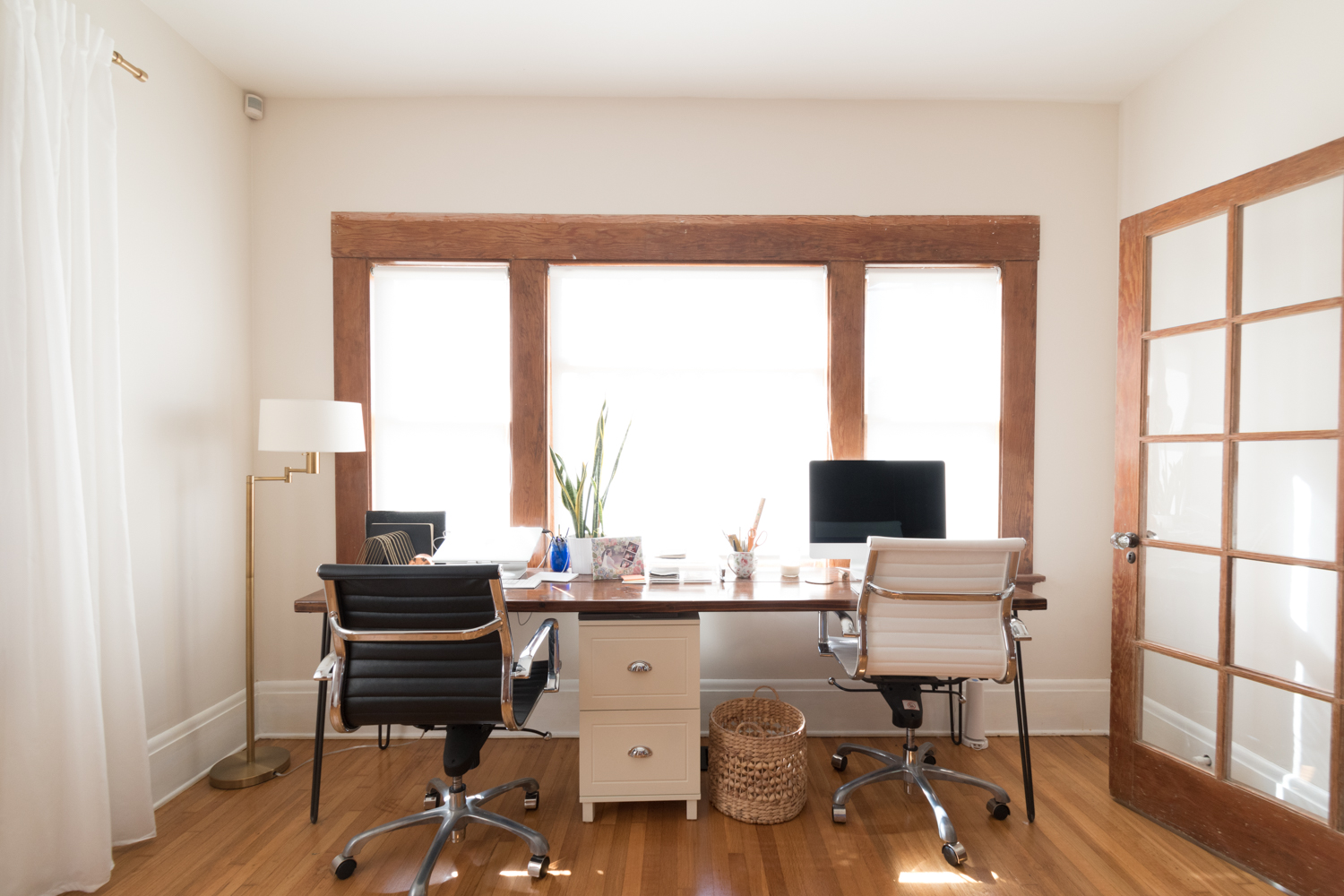
I built the desk about five years ago to fit in our old house. The size works, but the sunshine from the window is a killer. It's so bright and hot that I feel like I'm working on the surface of the sun. So, problem 1: desk orientation.

The desk orientation is unfortunate for ocular-comfort, but it also doesn't do anything for the layout of the room. We have a big open space in the middle with absolutely nothing going on. Problem 2: room layout.

The hutch was a great estate sale find but it doesn't help with our storage needs. It has glass shelving for displaying pretties - which none of our office things are. It lacks drawers for files, so we have a little filing cabinet under the desk. Yet, neither of these combined units fit the bill for an efficient office. Problem 3: storage.

I painted the walls the same color as the living and dining room (Sail Cloth by Behr) then never decorated. There's no art, no pattern, no interest. Problem 4: boring aesthetics.
Luckily, I have a plan for the bland room and I can't wait to get started! This space is in for one heck-of-a-transformation. I hope you'll follow along and encourage me when my arm goes numb from hand painting that mural!
If you're tuning in via the One Room Challenge and want to stay up to date on the progress of this project and see what I have coming in the future, subscribe to get blog posts in your email! Also, follow along on Instagram where I'll share stories of the transformation along the way.
Be sure to check out the featured design participants here and fellow guest participants here, too!
Fall One Room Challenge progress:
Week 1 - the before, the inspiration, and the plan
Week 2 - preparing for a bold wall mural
Week 3 - tricks for creating a perfect wall mural
Week 4 - painting the mural
Week 5 - walls, windows, and shades
Week 6 - IKEA storage hack
Week 7 - the reveal!
Look back at the Spring One Room Challenge:
Week 1 - the before, the inspiration, and the plan
Week 2 - paint, paint, paint
Week 3 - how to install picture rail molding
Week 4 - sourcing the artwork
Week 5 - refreshing a chair
Week 6 - the reveal!
I've been reading Design*Sponge for a decade, so just imagine my thrill seeing our home on one of my favorite design resources! In case you missed it, the full write-up including before-and-afters, as well as a source list, is below. Enjoy!
Ross and Ashley Goldman and their cat, Mabel, have lived in their 1915 San Diego, CA craftsman for two years. Much of that time has been spent making their house into a home, highlighting the beautiful original details of the century-old structure, and creating a modern respite fit for sitting back and reflecting on all of their hard work. All of which led Ashley to create a blog to document their renovations, The Gold Hive — a name created from a combination of their last name and the literal hive that was found in their home when they bought it. When she’s not working on the house, Ashley can be found at a local art museum where she works on programs with school kids, anthropomorphizing her plants and vintage portraits, or making pies.
Ashley and Ross both grew up in the suburbs, in 70s tract housing, only a few blocks away from each other. When they were looking to purchase their first home, they knew they wanted one with a little more history than those in which they spent their childhoods. Unfortunately, San Diego isn’t replete with historic districts. The couple looked for two years before they found their craftsman gem in a neighborhood only 15 minutes from downtown that somehow retains a small-town charm despite its proximity to the city center. With all of the charm, the mom-and-pop shops and restaurants, it’s not hard to imagine how difficult finding an available house in that neighborhood would be — Ross didn’t even see their house before Ashley had to put an offer in because he was working out of town (he’s an audio engineer for live events) and there were only two days the home was being shown!
One thing the “before” photos can’t accurately depict is the stench that awaited the industrious couple. Ashley remarked that it was so bad at first that they could barely stand inside — a delightful combination of old cigar smoke and pet urine. “It took us three months of floor refinishing, wall retexturing, cleaning, electrical updates, and a restored bathroom before we could move in. We did a lot upfront to get the house to a place where we could put our things inside, but for the past two years since then, we’ve taken a slow approach to renovations and decorating,” Ashley shares. While there was something of a rush to make their home livable, since then the actual decorating of the space has had an organic flow that took shape as Ashley stumbled upon a perfect piece of art, vintage piece, or as they needed furniture. They’ve also not rushed into remodels, but instead lived in their home, hosted parties, friends, and holiday gatherings learning exactly what their needs are before launching into a project. While they don’t feel like their home is “done,” they actually relish in the process and the discoveries they make in getting there, and now, at least for a little while, they get to kick back and watch their favorite Netflix dramas. Follow along to see the work they’ve done so far, and hear what they still dream of changing up. —Rebekah
Photography by Dani Toscano
Image above: “Here is a view into the den and down the hallway to the bathroom. It isn’t the biggest of masters, but with the adjoining den, it feels like a suite. One day, we hope to add a bathroom to the master. The photo over our bed is from our wedding and it is printed as an engineering print for $7 at Staples. I hung it up two years ago when I felt like I needed something temporary on the walls and it’s stayed this whole time,” Ashley explains.

While Ashley and Ross' kitchen has gone from dark and dated to bright and welcoming, it's not yet in its final iteration. The couple will be doing a remodel at some point in the future to make their kitchen more of a workhorse. "The kitchen earned so many changes without affecting the footprint. New counters, paint, hardware, lighting, appliances, counter space, backsplash, and flooring. The only thing that stayed unaffected by the kitchen updates was the fridge. It merely got a heavy cleaning," Ashley shares.

Ashley's rare find proves new isn't always necessary, "I got this vintage O’Keefe & Merritt stove at an estate sale down the street when I found that the existing one was in disrepair. I’ve scrubbed the whole thing clean, and it works just as well as the day it was made."

"The garden window above the sink is the perfect home for houseplants. They do double duty as greenery decor as well as hiding the neighbor’s trash cans," Ashley admits.

Ashley's problem-solving creates a stylish corner and further functionality: "The corner of the kitchen had no storage or counter space, so I made a floating countertop to extend our work surface and prep area."

"It’s amazing what some paint and new hardware can do. I also coated the tile counters in [a] few layers of concrete," Ashley explains.

"My hobby other than restoring the house is making pies and experimenting with new recipes," Ashley shares.

“We kept all of the original stone and woodwork, but gave the walls a new texture coating after repairing all of the cracks throughout the home. The living room is a formal sitting room. We love the architecture in this space, so we opted not to put a TV here. While it’s a ‘formal’ room in the sense that it isn’t designed to be a place to binge-watch Netflix, I want the space to be comfortable. I chose to pair two non-matching chairs to make the space feel more casual,” Ashley explains.

“Between the living room and office are a set of French doors. I love how the individual panes frame the view of the fireplace.”

Ashley explains what makes their little family such a good fit, “Our cat, Mabel, is big on snuggles and plush pillows. She fits in nicely with us because we like the same.”

Ashley shares the story of where her chandelier came from in a most relatable way: “I got this art deco chandelier after I fell in love with a similar one on Nicole Curtis’ show, Rehab Addict. It’s called a wedding cake chandelier and I love the round, feminine shape it adds to a room that’s full of rectangular shapes.”

“The built-in room dividers between the living room and dining room have ample space for my tchotchkes and a few of our favorite reads. I try to sprinkle art around the home no matter how small,” Ashley explains.

Ashley describes her style, “I’m drawn to basic and minimal designs that still have something special. This chair from Article has an interesting metal shape that complements that brass throughout the house. I’m also a big fan of buffalo check and it makes an appearance in nearly every room.”

“On the mantel live brass candlesticks and a mirror from a local estate sale along with a few of our favorite framed pieces. The Kids on the Shore print by Tali Yalonetzki came from Artfully Walls and I adore the painterly quality and blue tones. It’s a reoccurring theme with the art I gravitate towards. The photo of Ross and me is from our wedding day when we got married in the gardens of the historic Marston House Museum,” Ashley shares.

Ashley found a luxurious solution to Mabel’s destructive habits, “The cat loves scratching on our furniture and we’ve found that velvet is the one material she can’t destroy. Not only does she not ruin this chair, but it’s her absolute favorite and she can be found lounging in it all the time. It’s from Article and what I love about it is that it’s a scaled down version of a wingback chair.”

“When I toured the house it was a nighttime, so I had no idea how much natural light would flood into the house. We have lots of windows, and these west-facing Chicago style windows show off great views of the sunsets, and even 4th of July fireworks,” Ashley explains.

Ashley describes some of the steps they took to making this space more livable, “The hardwoods in the dining room were marred by pet stains. The floors were refinished and much of the damage is repaired, or hidden under the rug. I painted the walls the same color from floor to ceiling to make the space feel bigger. The built-in buffet is what truly sold me on the house. The intact leaded glass and 100-year-old mirror were added bonuses! The door to the left of the buffet swings both directions and leads into the kitchen. The chairs are inspired by the classic molded Eames chair, but these have a plush seat which makes long meals extra comfy.”

“I wanted a chandelier more modern than the one in the living room, and one that had a slim profile that wouldn’t compete with the buffet. This piece was custom ordered to fit our space from an Etsy shop,” Ashley explains.

“I’m a sucker for vintage oil paintings, especially portraits. I refer to this gal as ‘my pretty lady’ and feel like she’s a part of my family,” Ashley admits.

“The previous homeowner left us a bunch of dirt and grime to clean up after him, but he also bestowed this painting of our house from a decade ago when it was featured in the historic home tour.”

“The bathroom was entirely gutted down to the crawl space and up into the attic. The floor was rotting and the plumbing was corroded. This space was the first big remodel when we got the house and it’s still a favorite. We took the classic subway tile all the way to the ceiling in the shower, and at a chair rail height around the rest of the walls. The dark grout gives a heritage feel and ties into the dark paint on the walls. Everything in the space is new except for both of the light fixtures and the original medicine cabinet.”

“We did a dark charcoal on the walls to add contrast to the bright white tiles,” Ashley says. “I played with mixed metals in this space and did black, chrome, and brass. Some may not love the combination, but we do.”

The remodel revealed a little unexpected extra storage, “When we redesigned the space, there was room at the foot of the tub for a tall storage unit and behind it was space for a recessed niche in the corner of the shower. It’s tucked out of sight of guests, but so handy while showering.”

Ashley goes over the before and after details of the second bedroom that was turned into a den: “This room got refinished floors and retextured walls like the rest of the house. We also removed the garden window and replaced it with a wood double-hung window to match the style and materials used throughout the rest of the house. The second bedroom is where we watch TV, and it doubles as a guest bedroom with this pull-out couch from West Elm.”

“This St. Bernard print from painter Mary Sinner is one of my favorites in the house. It pops on the green walls that transition from green to blue to nearly black throughout the day,” Ashley shares.

“This room is right off of the master and close to the kitchen,” Ashley explains. “You could walk the house in one loop and pass through each of the rooms. The flow is perfect for us now, but we may move some walls when this room becomes a kid’s room.”

“I reupholstered that chair, and decorated with layers of blues and greens,” Ashley shares.
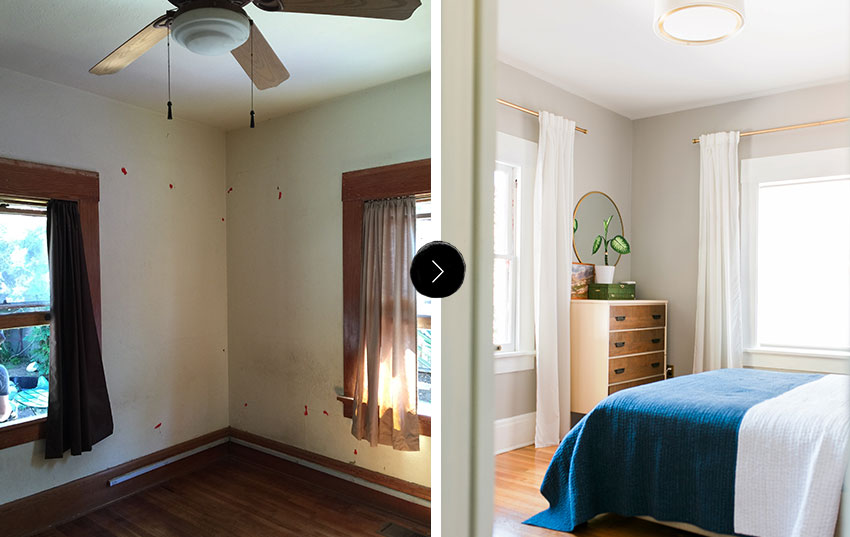
The beautiful refinished floors and freshly painted walls continue into the master bedroom makeover.

“The painting is from a flea market, the jewelry box is from Etsy, the dresser is from Craigslist, and the mirror is from Target. This is a perfect example of how I collect items for our home. The Sonos is never not playing music or a podcast at home. When Ross travels for work, our soundtrack keeps me company,” Ashley shares.

“The quilt is handmade and purchased from Etsy — perfect for our summery days. All of the furniture in the master came from our old apartment and I’m growing tired of it. The beauty of buying off Craigslist is selling the same items on Craigslist,” Ashley explains.

“This early-1900s painting sits on the floor, but that doesn’t mean I love it any less.”

“The chunks of concrete and overgrown landscape were taking over the facade of the house. The craftsman elements were finally able to breathe after we cut back all of the overgrowth. We recently installed a low-water garden in the front yard. It’s still young but already flourishing,” Ashley shares.

Ashley, Ross, and Mabel, all sitting pretty in their lovely home.

A clear layout of Ross and Ashley’s 1,400-square-foot, three-bedroom, one-bath, 1915 San Diego craftsman home.
Paint color- “Sail Cloth” by Behr
Green and brushstroke pillow – Cotton & Flax
Art on Mantel- The Kids on the Shore print by Tali Yalonetzki from Artfully Walls
Paint-by-numbers painting of mountain- vintage (similar)
Brass cranes- vintage (similar)
Brass fireplace tools with horse heads- vintage (identical)
Wedding photo- Photographed by Stacy Keck, framed by Framebridge
Striped Blanket- Paradise People
Blue velvet chair- Article
Ivory chair- Article
Floor lamp- Target
Table lamp- World Market
Hand print- Society 6
Green landscape painting- Artfully Walls
Ram head bookends- vintage (identical)
Side table- discontinued from Target (similar)
Polka dot vase- Anthropologie
Chandelier- vintage (similar)
Coffee table- Craigslist (similar)
Rug- West Elm
Buffalo check pillow- Amazon
Paint color- Sail Cloth by Behr
Table- World Market
Chairs- Amazon
Rug- West Elm
Chandelier- custom from Illuminate Vintage on Etsy
Flowers- Native Poppy
Print- The Denny’s Parking Lot by Esther Pearl Watson from 20×200
Droplet art- Anthropolgie
Pretty Lady painting- vintage from Mesa Vintage (similar)
Hanging planter- Wayfair
Paint color- “Antique Tin” by Behr
Tub- Kohler
Shower and sink fixtures- DXV
Console sink- Signature Hardware
Wall sconce- vintage (similar)
Pendant light- vintage (similar)
Wall tile- The Tile Shop
Floor tile- The Tile Shop
Glass shelf- Rejuvenation
Soap dispenser- CB2
Candle- Sydney Hale Company
Medicine cabinet latch- House of Antique Hardware
Medicine cabinet hinges- House of Antique Hardware
Turkish hand towel- Amazon
Nude print- Etsy
Paint color- “Schooner” by Behr
Rug- Rejuvenation
Tile- Amazon
Stove- vintage (similar)
Mirror- Vintage from Loveseat (Similar)
Planter by cookbooks- Moonbird Pottery
Light over sink- Amazon
Mixer- Amazon
Paint color- “Salamander” by Benjamin Moore
Rug- eCarpet Gallery
Curtains- Ikea
Couch- West Elm
Side table- Article
Wall art above couch- Lucie Birant from Society 6
Pillow- Article
Ottoman- Minda Living
Tray- CB2
Floor lamp- Article
Chair- Craigslist (similar)
TV cabinet- vintage (similar)
Chandelier- West Elm
St. Bernard print- Mary Sinner from Artfully Walls
Feral House print- James Griffioen from 20×200
Floral pillow- Society 6
Picture rail molding- House of Antique Hardware
Picture rail hooks- House of Antique Hardware
Candlesticks- World Market
Table lamp- vintage (similar)
Paint color- “Silver City” by Behr
Quilt- custom from VLiving from Etsy
Curtain rods- Amazon
Curtains- Ikea
Sconces- Allmodern
Bedding- Target
Bed- Amazon
Dresser- vintage (similar)
Side table- vintage (similar)
Print above bed- Photographed by Stacy Keck (smashingweddings.com), printed as engineering print at Staples
Flush mount light- Rejuvenation
Mirror- Target
Jewelry box- vintage (similar)
Sonos- Amazon
Landscape painting- vintage (similar)
Fruit painting- vintage ( similar )
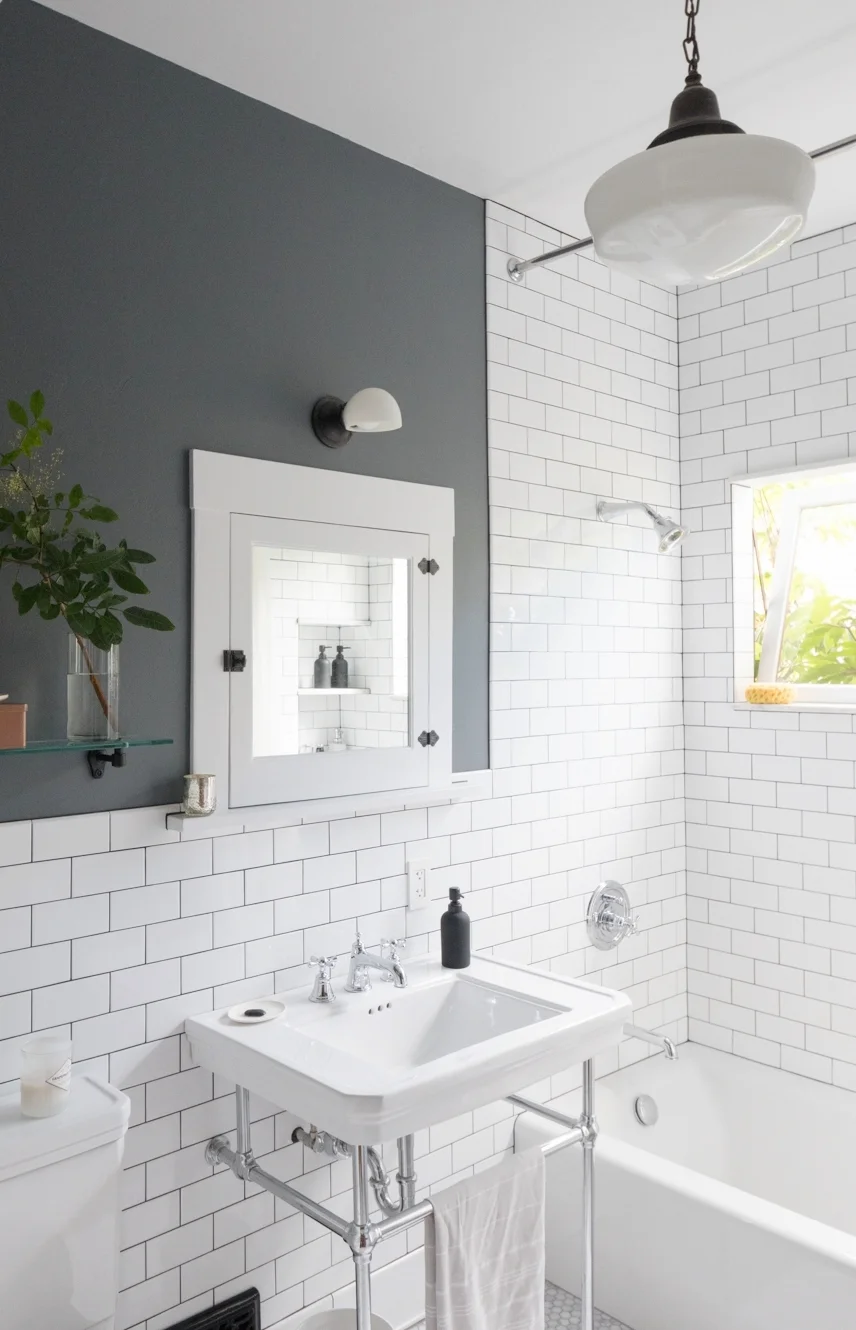
Welcome to the renovated bathroom! It was gutted and rebuilt two years ago, but it continues to evolve. Shall we take a look at what she looked like before we demolished everything?
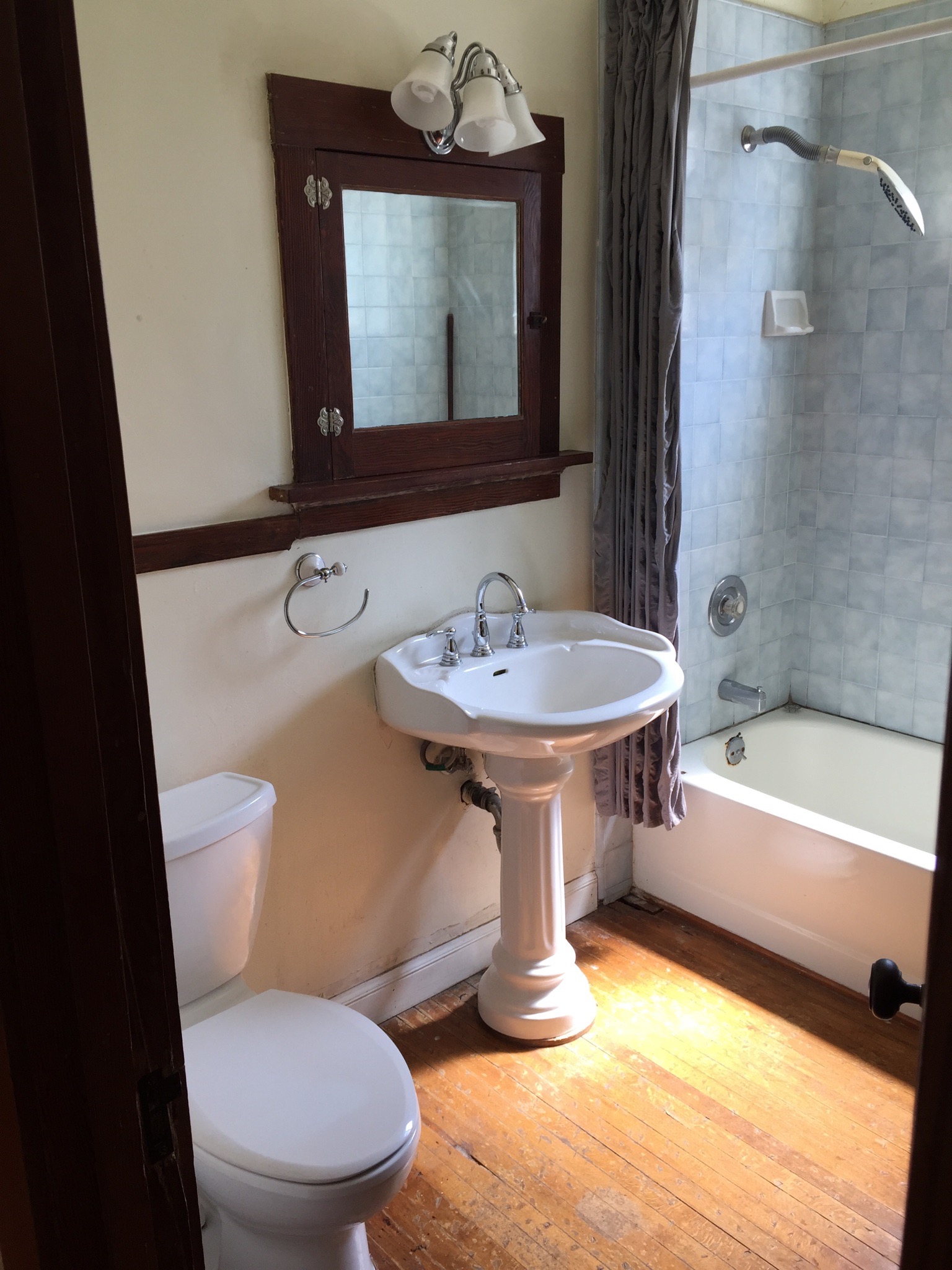



And for that satisfying side-by-side, I give you this.
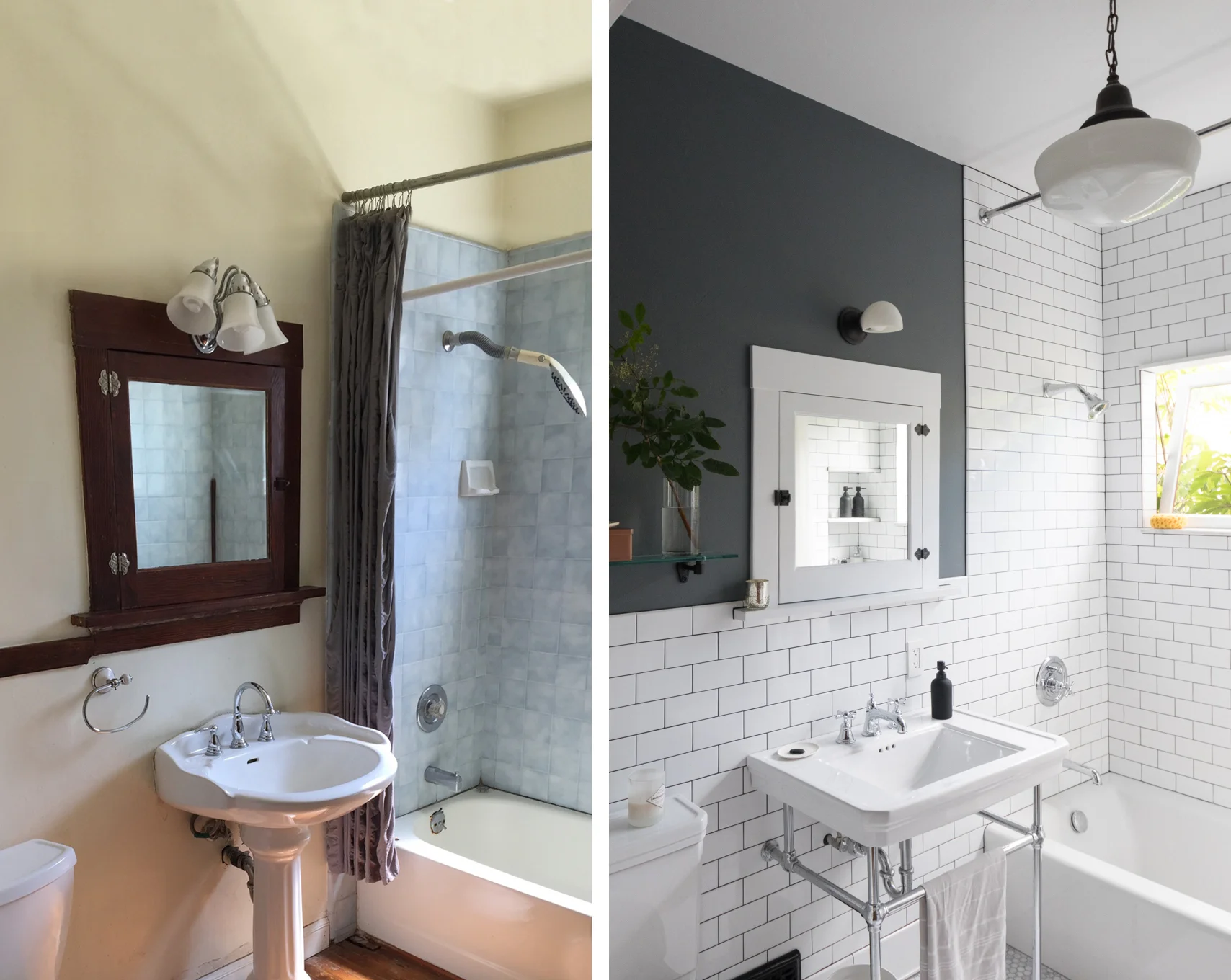
This is our one and only bathroom in the house and it's been serving us so well after we did a number on it. As a refresher, here are all of the posts I've written about the bathroom so far:

We gutted the whole room and the only elements that were worth saving were the door, and the medicine cabinet. They got a good cleaning and a fresh coat of white paint that was custom color matched to the white tiles.
The walls were coated in Behr's Antique Tin which is the perfect deep grey that's neither too blue nor too warm.

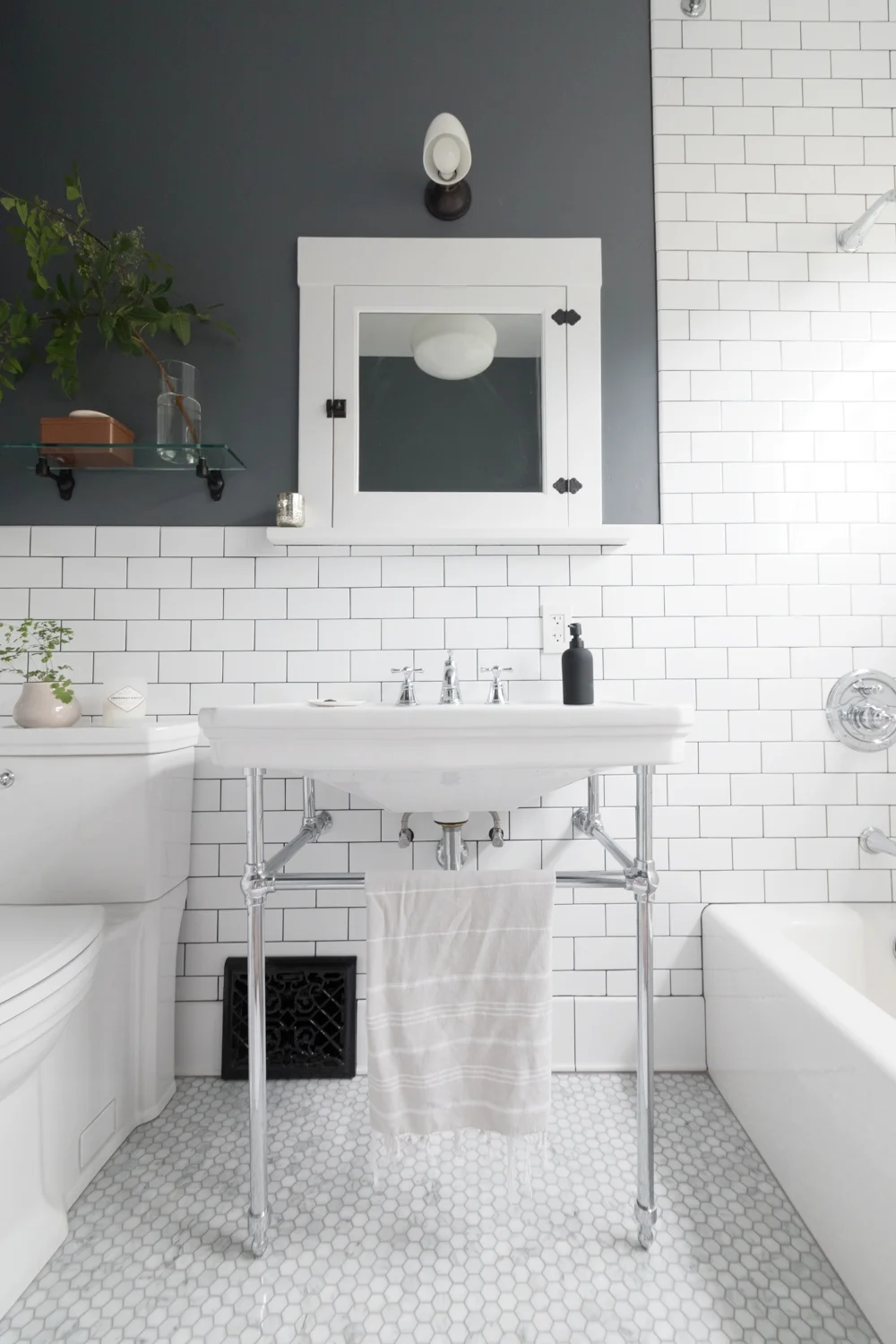
The console sink sits front and center in the bathroom. We opted for a console-style sink that would keep things open and airy. I waffled between a few styles before picking this leggy chrome beauty.

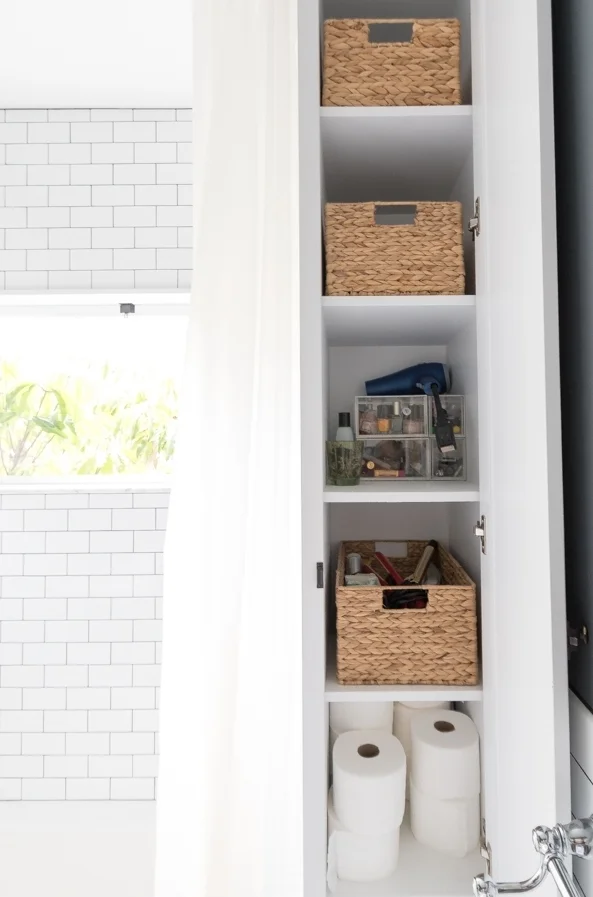
Since it's clear that the sink can't be used for storage, we built a spiffy cabinet at the end of the tub. Baskets hold all of our toiletries, and then more storage is accessible from inside the shower for our shampoos.


The plumbing fixtures on the sink and in the shower are all from the DXV by American Standard Randall line. They are good reminders that we're in an old house with their vintage-y vibes.


The tile is the star of the show in this bathroom. We went for a simple subway tile and a bullnose edge detail on the walls. The dark grout was a must and I couldn't be happier with how crisp and clean it looks two years later. The marble hex flooring gives just a touch of sophistication without making the space feel too precious.

I'm definitely a fan of mixed metals. We did chrome throughout with black accents. The light fixtures are both vintage brass that have earned a dark patina after years of aging. The window hinges are brass and will continue to patina over time.


The bathroom previously didn't have an air vent, so when we decided to add one, I wanted an old vent with some pizzazz. I found this wall vent at a local architectural salvage shop covered in paint and rust. After a trip to the powder coater it came back with the most glossy black finish.

Notice on the side of the toilet that you don't see the curvy shape defining the route of all of your flushed items? We went with a skirted (or concealed trapway) toilet which makes such a visual difference.

Can we talk about that window for a second? The previous bathroom had a lil' frosted glass one with an aluminum frame that was corroded and didn't open. This 45"x26" custom wood window brings in so much light and lets out all of the steam and moisture after a hot shower. The oversized window with a transom-style opening is one of my favorite features of the whole bathroom.


We opted for a cast iron tub from Kohler (as opposed to acrylic) and I love how solid it feels. There's no flex underfoot, it keeps tub water warm longer, and it's the right material for our old home. This particular tub is a favorite because of the flat apron which was hard to come by within our budget.


How about that artwork? I feel like it was painted just for this bathroom.


I really could go on and on about this space! For all of the posts about the bathroom, click here. And to shop the room, click on the product images below!
Note that a few of the pieces in our bathroom are vintage, so I linked to similar ones.
Hammocks, cookbooks, gardening, sewing, and the other things I’ve been up to on my impromptu break, and more.
Where I’ve been, shooting on film, my dream house, retro costume inspiration, energy rebates, a magic cake, textiles I don’t need but want, a lampshade DIY, my best defense against mosquitos, a new podcast, what’s killing home remodelers, best decision-making advice, overheard parenting, Little Women on acid home tour, best marble etch remover, and more.
If you like florals and color, this bathroom is for you. If you don’t, well, maybe scroll through and you’ll be converted? Or not? Either way, here’s the reveal of a bathroom addition that’s finally here - after a whole three years of construction.
My baby is two! Time’s flying… we wish we could slow down these years… I can’t believe she’s two… and all those other cliché things to say. We celebrated her second trip around the sun in our backyard with a small gathering of friends.
What I’m binge watching, the things I ordered for summertime fun, an incredible legacy, ranking films, a dozen things to say to your kids daily, design decisions, sibling bonds, and more.
I have such love for my historic house, but I’ve shamefully been neglecting the exterior paint. The tired finish was peeling and the faded colors did no justice to the architectural beauty of my 1915 craftsman bungalow. It was time for a change - a transformation that would honor the home's history while infusing it with fresh energy.
The thrill of renovating outdoor spaces is they always get better with age. We overhauled our backyard last year and the plant growth during this last trip around the sun is wild! Get ready for lots o’ photos.
Ashley has been restoring her craftsman bungalow since early 2015. The Gold Hive chronicles the journey of DIYs, restorations, renovations, and stories.
I'm Ashley, a type-A homebody fixing up my historic home at a snail’s pace in California. I share home improvement DIYs, tips for sustainable living, and renovation stories - all while aiming to add more color and present real, lived-in spaces.

© 2024 Ashley Goldman / All Rights Reserved
Please do not use any images without proper credit (a link back to my site/social channels within the first 120 characters).
The Gold Hive contains affiliate links in sidebar banners, in images on the Shop The House page, and as text in select posts. This means that I may earn a small commission if you purchase something I recommended. Sponsored posts or gifted products are noted as such. All opinions are my own. Thank you for supporting bloggers and creators.
What I’ve been up to - from gardening, to film photography, and the books and shows we’re enjoying. Plus a house tour that requires a closer look, grass seed to always have on hand, cedar shake excitement, historic window screens, and the privilege I’m reminded of daily.